Cats
Top 7 Most Common Cat Breeds
Feline enthusiasts, uncover the fascinating world of the top 7 most common cat breeds, each with its own unique charm and captivating traits.
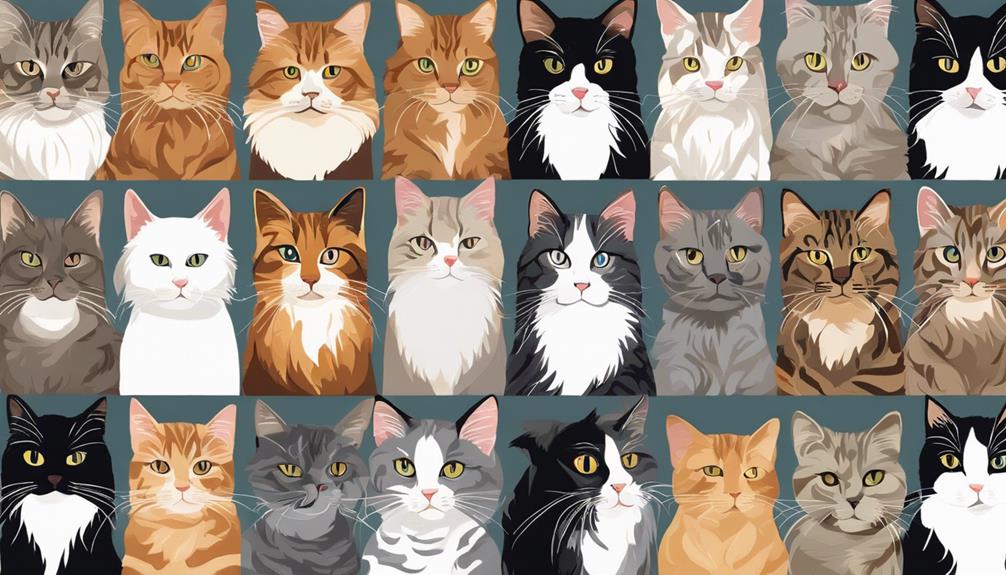
Let's explore the top 7 most common cat breeds! First up, the British Shorthair with round faces and thick coats. Siamese cats boast striking blue eyes and high intelligence. Persian cats are regal with luxurious fur. Maine Coons are known for their size and water-resistant coats. Ragdolls have gentle temperaments and enchanting blue eyes. Abyssinians are sleek and active with distinctive coat patterns. Finally, Bengals are highly energetic and affectionate. Each breed brings unique traits and personalities. Discovering more about them could help you find the purrfect companion for your home.
Key Takeaways
- British Shorthair: Round faces, thick coats, calm temperament, long lifespan.
- Siamese: Striking blue eyes, highly intelligent, social, require mental stimulation.
- Persian: Regal appearance, luxurious fur, friendly with strangers, prone to health issues.
- Maine Coon: Majestic size, water-resistant coats, loving nature, fourth most popular in America.
- Ragdoll: Gentle demeanor, plush coats, alluring blue eyes, gentle giants, graceful.
British Shorthair
We love British Shorthair cats for their distinctive round faces, thick coats, and large, expressive eyes. As one of the oldest cat breeds globally, originating in Britain, British Shorthairs have a timeless allure that captures our hearts. Their calm temperament makes them ideal companions for families, bringing a sense of peace to any home. These cats aren't just beautiful; they're also robust and generally healthy, with a lifespan ranging from 14 to 20 years, providing long-lasting companionship.
The round face of a British Shorthair gives them an adorable, almost teddy bear-like appearance that's irresistible. Their thick coat adds to their charm, making them soft to touch and lovely to cuddle. Those large, expressive eyes seem to speak volumes, drawing us into their world of serenity and grace. In various colors and patterns, the blue British Shorthair remains a favorite among cat lovers for its unique and enchanting beauty.
Siamese

Moving on to the Siamese breed, known for their striking blue almond-shaped eyes and originating in Thailand. Siamese cats aren't only beautiful but also highly intelligent and social creatures. Their sleek coat and mesmerizing eyes make them stand out among other breeds.
These cats are famous for being vocal and craving human interaction, enjoying the company of their family members. Because of their intelligent nature, Siamese cats require mental stimulation to keep them engaged and content. It's crucial to provide them with toys and activities to prevent boredom.
Despite their loving nature, Siamese cats can get lonely if left alone for extended periods. This breed may have a shorter lifespan compared to others, so it's vital to give them the attention and care they need throughout their lives. If you're looking for a cat that isn't only beautiful but also intelligent and social, the Siamese breed might be the perfect match for you.
Persian

With their regal and distinguished appearance and luxurious fur coats, Persians are highly recognized in the world of cat breeds. These long-haired cats boast a regal appearance that demands attention and admiration. Their calm nature makes them ideal companions for quiet environments, where they can be seen lounging gracefully around the house.
One important aspect of caring for Persians is grooming. Their beautiful long coats require regular attention to keep them looking their best. Additionally, Persians are known to be friendly with strangers, often enjoying the company of new faces and welcoming them with ease.
Despite their many positive traits, Persians are prone to health issues such as obstructive airways syndrome, a condition related to their flat noses. This is something to keep in mind when considering this breed. Overall, Persians make wonderful pets for those who appreciate their regal charm and are willing to provide the care they need to thrive.
Maine Coon

What makes Maine Coon cats stand out among other domestic breeds is their remarkable size and majestic appearance. Originating in North America, these friendly and sociable felines are the largest domestic cat breed.
Maine Coons have dense, water-resistant coats that set them apart from other cats and may even enjoy playing in water. Despite being mistakenly thought extinct in the 1950s, Maine Coons have made a strong comeback and are now the fourth most popular cat breed in America.
Their loving and outgoing nature makes them excellent companions, often following their human family members around the house. If you're looking for a large, friendly, and sociable cat, the Maine Coon might be the perfect fit for you. With their impressive size and affectionate demeanor, it's no wonder these majestic cats have captured the hearts of many cat lovers.
Ragdoll
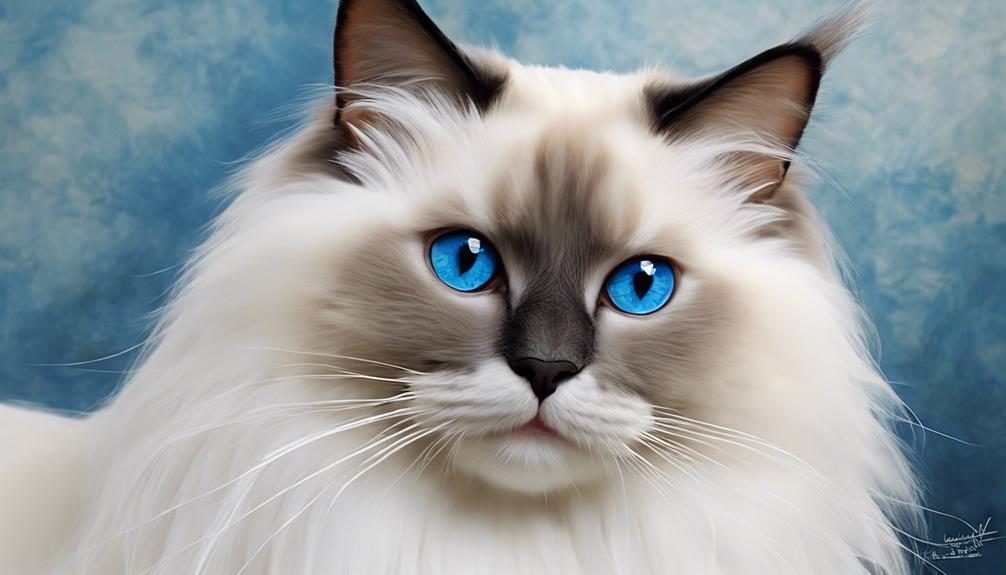
Ragdolls are cherished for their stunning appearance and gentle demeanor. With their plush coats and alluring blue eyes, these feline friends make wonderful companions.
Known for being patient and affectionate, Ragdolls are ideal for families with children.
Ragdoll Characteristics
Known for their beautiful fluffy coats and striking blue eyes, Ragdolls are a breed cherished for their calm and affectionate temperament. Here are three fascinating characteristics of Ragdoll cats:
- Gentle Giants: Ragdolls are a heavier breed, but their size matches their loving nature, making them great companions for families with children.
- Purrfect Temperament: With a deliberately bred calm temperament, Ragdolls excel in providing comfort and affection to their human companions.
- Growing Gracefully: These feline friends reach their full size potential around 4 years of age, allowing for a gradual and graceful development into their majestic stature.
Ragdolls truly embody beauty, grace, and a loving personality, making them a wonderful addition to any home.
Ragdoll Care Tips
Taking care of a Ragdoll involves providing regular grooming and attention to their specific needs for best well-being. These affectionate and calm-tempered gentle giants with stunning blue eyes require minimal grooming due to their soft fur, resulting in less shedding.
Due to their large size, Ragdolls need ample space to roam and play. It's important to create a safe environment for them to explore. Regular vet check-ups and a balanced diet are essential for their best health. Keep an eye on their weight to prevent obesity, a common issue in Ragdolls.
Engage in interactive play sessions to stimulate their minds and keep them active. By meeting their needs, you'll guarantee a happy and healthy life for your Ragdoll, the popular feline companion.
Ragdoll Temperament
When caring for a Ragdoll, understanding their gentle and affectionate temperament is key to fostering a harmonious bond with these docile felines. Here are three key traits that make Ragdolls stand out:
- Calm and Affectionate: Ragdolls are known for their calm demeanor and love for affection, making them ideal cuddle buddies.
- Gentle and Loving: These cats are gentle in nature and show immense love towards their human companions, seeking out attention and physical contact.
- Friendly and Sociable: Ragdolls aren't just friendly with people but also get along well with children and other pets, showcasing their sociable personality.
Understanding these characteristics will help you create a loving and nurturing environment for your Ragdoll.
Abyssinian

Abyssinian cats are distinctive for their sleek bodies, lively personalities, and striking coat patterns. Their active and playful nature makes them ideal pets for owners seeking a dynamic and engaging companion. The unique ticked coat pattern of Abyssinians sets them apart from other breeds and adds to their charm. With their need for regular exercise and mental stimulation, these felines are well-suited for households that can provide ample playtime and enrichment.
Characteristics of Abyssinian Cats
Originating from southeast Asia and subsequently bred in Britain in the late 19th century, Abyssinian cats are renowned for their slender, active build that mirrors their agile nature.
When considering Abyssinian cats, there are a few key characteristics to keep in mind:
- Oldest Cat Breeds: Abyssinians are among the oldest cat breeds, with a history that dates back centuries, showcasing their enduring appeal.
- Distinctive Coat: Their ticked coat pattern sets them apart, adding to their allure and unique appearance.
- Interactive Companions: Abyssinians thrive on attention and engagement, making them ideal for those seeking lively and responsive feline companions.
These traits make Abyssinian cats not only historically significant but also interactive and charming additions to any household.
Popularity of Abyssinian Breed
The Abyssinian breed of cats has gained significant popularity in recent years due to their distinctive characteristics and engaging personalities. Originating from southeast Asia and bred in Britain in the late 19th century, Abyssinian cats are known for their slender build, active nature, and playful demeanor.
Their striking ticked coat pattern sets them apart, along with their curious and inquisitive behavior. Abyssinians thrive on attention and regular activity, making them ideal for owners who enjoy an interactive pet.
With an average lifespan of 14-20 years, these feline companions can provide long-lasting joy and companionship. If you're seeking a lively and affectionate cat that will keep you entertained for years to come, the Abyssinian breed might be the perfect choice for you.
Bengal
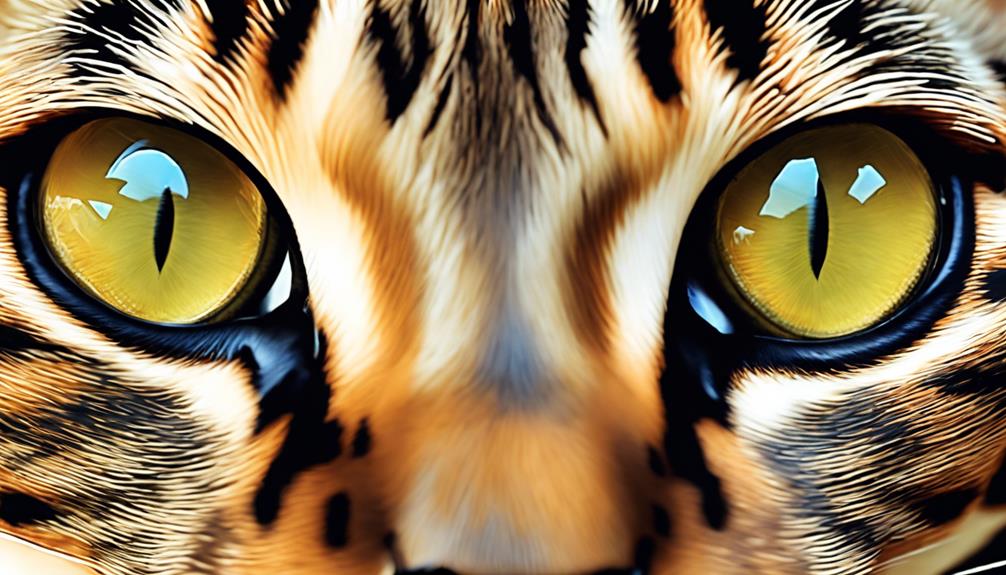
Exploring Bengal cats reveals their distinct wild appearance resembling a baby leopard. These feline beauties captivate with their memorable markings and striking coat patterns, making them stand out in any room. The Bengal's unique heritage as a part-wild breed adds to their allure, giving them a mysterious and exotic charm that many find irresistible.
- Wild Beauty: The Bengal cat's resemblance to a baby leopard isn't just skin deep; their playful nature and energetic disposition add to their wild charm.
- Exercise Enthusiasts: To keep a Bengal cat content, ample exercise is a must. Interactive toys and climbing structures can help satisfy their active instincts.
- Rare Gem: Being a rare breed, Bengals often come with a higher price tag. However, their extraordinary beauty and lively personality make them a prized companion for those who appreciate their unique qualities.
Owning a Bengal cat is like having a piece of the wild right in your home, a constant reminder of the untamed beauty of nature.
Frequently Asked Questions
What Are the 10 Popular Cat?
Familiar are the top 10 popular cat breeds like Siamese, Maine Coon, Ragdoll, British Shorthair, Bengal, Persian, Abyssinian, Scottish Fold, Sphynx, and Russian Blue. Each has unique traits loved by cat enthusiasts worldwide.
What Is the #1 Cat Breed in the World?
We adore Domestic Shorthairs, the top cat breed worldwide. With their mixed heritage, sleek coats, and round faces, these versatile felines date back to ancient Egypt. They're beloved for their adaptability and companionship.
What Breed of Cat Is Most Common?
We believe the most common breed of cat is the Domestic Shorthair. These versatile cats come in a variety of colors and are well-loved for their unique personalities. They can be found in shelters due to their prevalence.
What Is the Top 10 Rarest Cat?
When considering rare cat breeds, we'd highlight the Sokoke, American Wirehair, Chartreux, Kurilian Bobtail, and Minskin. These unique felines boast distinct features and histories, making them sought after by enthusiasts looking for something truly special in a pet.
Conclusion
To sum up, the top 7 most common cat breeds offer a variety of personalities and characteristics that can suit any cat lover's preferences. From the playful Bengal to the regal Persian, there's a breed for everyone.
Whether you prefer a laid-back companion or an energetic feline, these breeds have something to offer. So, do your research and find the perfect furry friend that matches your lifestyle and personality.
Happy cat hunting!
Paul’s love for animals knows no bounds. As a dedicated writer and animal lover, Paul brings a unique perspective to our team. His firsthand experiences with various animals enrich our content and provide valuable insights into their behavior and needs. Whether he’s sharing tips for pet care or shedding light on pressing conservation issues, Paul’s passion for animals shines through in everything he does.
Cats
Can Cats Eat Turkey Safely?
Get insights on whether cats can safely eat turkey, ensuring their health and well-being – find out the dos and don'ts!

We can feed cats turkey safely if it's plain, boneless, well-cooked meat with no harmful seasonings to guarantee their health. Remember, cats are obligate carnivores, so protein-rich diets like turkey are beneficial. When cooking turkey for cats, avoid toxic seasonings like garlic and onion, and remove bones to prevent choking. Limit treats to 10% of their diet, offering small portions to prevent stomach issues. Turkey skin is high in fat, so it's best to offer sparingly, removing the skin. Consulting a vet is important for dietary advice. Guarantee your cat's safety by feeding them plain, safe turkey.
Key Takeaways
- Cook plain, boneless turkey for cats to avoid harmful bacteria and choking hazards.
- Remove skin before feeding to prevent digestive issues from high fat content.
- Avoid seasoned turkey with toxic ingredients like garlic and onion.
- Limit turkey treats to 10% of daily calories to prevent nutritional imbalances.
- Consult a vet if turkey becomes a significant part of the cat's diet for professional advice.
Cats and Turkey Diet
When considering the dietary needs of cats, it's important to understand their unique requirements when it comes to incorporating turkey into their meals. Cats, being obligate carnivores, thrive on protein-rich diets, making turkey an excellent choice for them. Turkey isn't only a suitable protein source but also low in fat and calories, making it a healthy treat option for our feline friends.
Including turkey in a cat's diet can offer variety and essential nutrients. Many commercial cat foods incorporate turkey as part of the protein component, showcasing its benefits for our whiskered companions. However, when offering turkey to cats, it's essential to confirm it's plain, cooked, and free from seasoning or skin. This simple preparation ensures that cats can enjoy turkey safely without any potential harmful additives.
Cooking Turkey for Cats
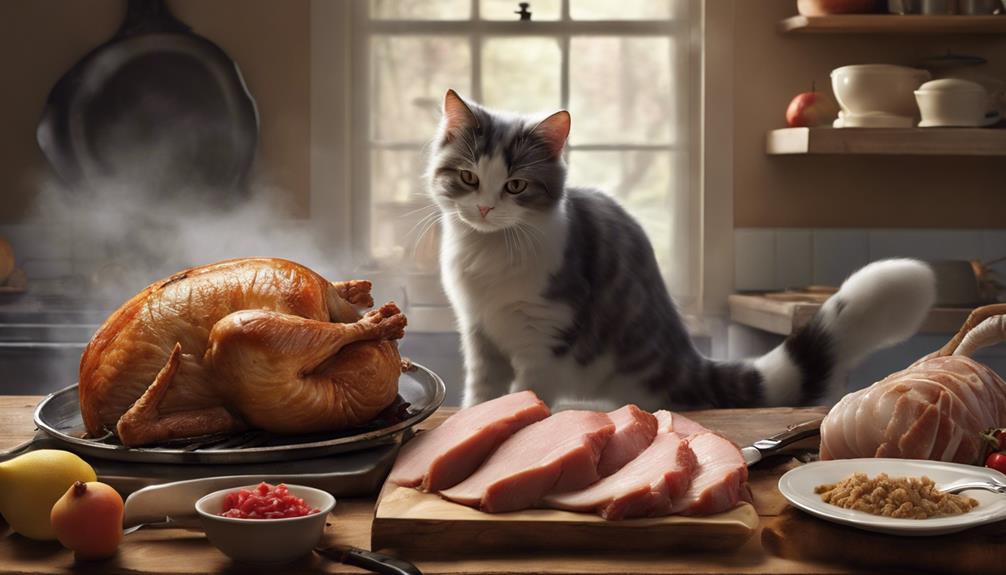
Moving from considering the dietary needs of cats in general, cooking turkey for cats requires careful attention to specific preparation methods to guarantee their safety and health. When preparing cooked turkey for our feline friends, it's essential to make sure the meat is thoroughly cooked to eliminate any harmful bacteria that could affect their well-being.
Additionally, it's important to avoid using seasonings like garlic, onion, or lemongrass, as these can be toxic to cats. Before serving the turkey to your cat, confirm that all bones have been removed to prevent any choking hazards. Offering plain, boneless, and well-cooked turkey meat can be a safe and delicious treat option for your cat.
You can also consider giving them unseasoned turkey organ meats in small amounts as a snack or meal topper, adding variety to their diet. By following these guidelines and being mindful of your cat's diet, you can prepare turkey in a way that's both enjoyable and safe for your furry companion.
Turkey Skin and Cats

Considering the potential impact on feline health, cats should be offered turkey skin sparingly due to its high fat content, which can lead to digestive issues.
While cats may find the fatty skin of turkey delicious, it's crucial to remember that their digestive systems are sensitive and too much fat can upset their stomachs. High-fat foods like turkey skin should be a rare treat for our feline friends to avoid any potential tummy troubles.
This is particularly important for overweight or obese cats, as excess fat consumption can worsen existing health issues. To prevent any digestive problems, it's best to remove the skin before offering cooked turkey to cats.
Turkey Seasonings Dangers
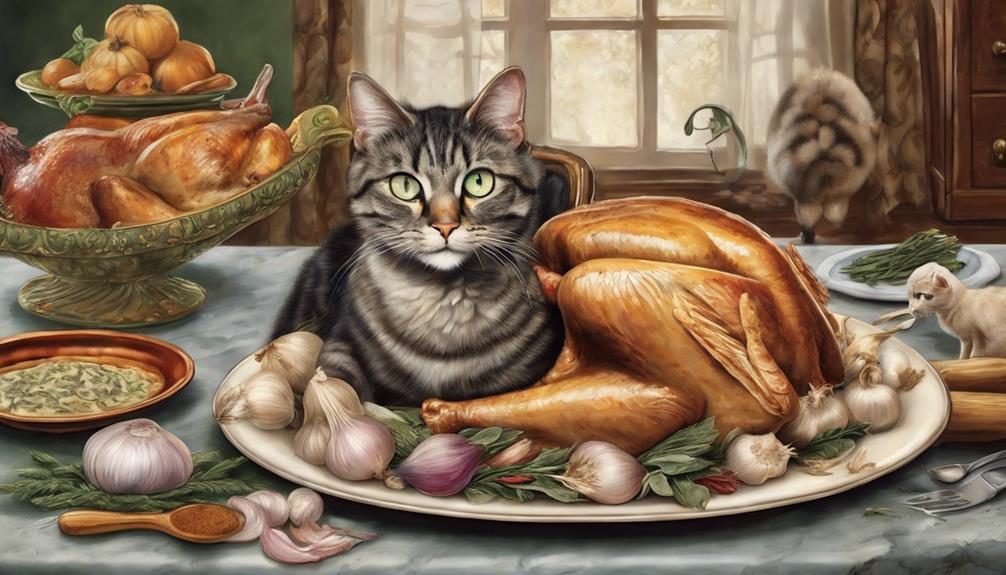
When it comes to feeding your feline friend some turkey, we need to be cautious about the seasonings we use. Some common spices like garlic, onion, and lemongrass can actually be harmful to cats.
Excessive salt intake from seasoned turkey can also pose health risks for our furry companions.
Seasoning Risks
To ensure the safety of cats, it's important to be mindful of the potential dangers of seasonings in turkey. Common seasonings such as garlic, onion, and lemongrass can be toxic and harmful to our feline friends. Cats should steer clear of seasoned turkey to avoid any unwanted complications that may arise from ingesting these seasonings.
Excessive salt intake from seasoned turkey can also lead to health issues in cats, making it vital to monitor their food intake closely. If your cat happens to ingest seasoned turkey, contacting a vet for guidance is essential. Remember, it's better to be safe than sorry when it comes to the well-being of our beloved pets.
Harmful Spices
We must be cautious of the harmful spices present in turkey seasonings that can pose serious risks to our feline companions. When it comes to our cats' health, avoiding seasoned turkey is essential. Here are some reasons why harmful spices in turkey seasonings can be dangerous for our furry friends:
- Toxic Ingredients: Garlic, onion, and lemongrass commonly found in seasoned turkey can be toxic to cats.
- Health Issues: Cats consuming seasoned turkey may experience various health problems due to the harmful spices.
- Avoidance is Key: It's important to steer clear of giving cats turkey with any added seasonings to prevent potential harm.
- Consult a Professional: If your cat accidentally ingests seasoned turkey, consulting a vet is vital to guarantee their safety.
Limiting Turkey Intake
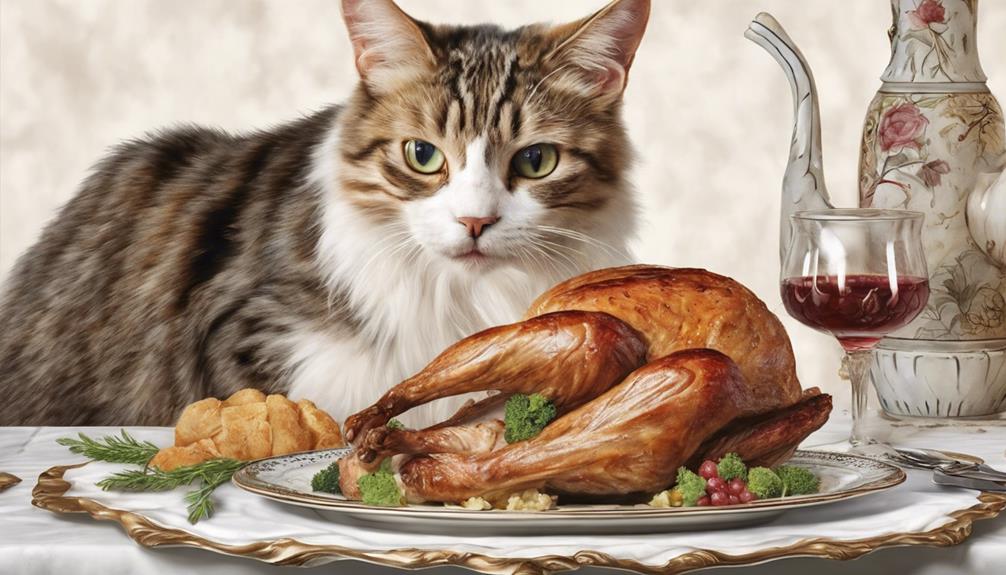
When it comes to feeding cats turkey, it's important to watch their intake closely. Overindulging in turkey can lead to potential health risks for our feline friends.
To make sure our cats stay healthy, we should stick to recommended portion sizes and frequency guidelines.
Portion Control for Cats
Managing a cat's consumption of turkey treats is crucial to maintaining their digestive health and overall well-being. To guarantee your feline companion stays healthy and happy, consider the following guidelines for portion control when it comes to giving them turkey treats:
- Restrict turkey treats to no more than 10% of a cat's total calorie intake.
- Recommended portion size for turkey treats is 2-3 thumbnail-sized pieces once or twice a week.
- Excessive indulgence in turkey treats can result in stomach upset and diarrhea in cats.
- Seek advice from a vet if turkey treats are a significant part of your cat's diet.
Potential Health Risks
To safeguard your cat's health, limiting their intake of turkey is essential due to potential health risks associated with excessive consumption. Cats are prone to pancreatitis if they consume too much turkey, especially seasoned or dark meat. It's important to keep cooked turkey treats to a maximum of 10% of their diet to prevent health issues.
Additionally, raw or undercooked turkey poses salmonella and listeria risks to cats, making it unsafe for consumption. Deli turkey meat, often high in sodium and containing harmful additives, can also be detrimental to your feline friend's well-being. By being mindful of these risks and moderating your cat's turkey intake, you can help safeguard their health and happiness for years to come.
Raw Turkey Risks

Feeding cats raw turkey poses significant risks due to the potential presence of harmful bacteria such as salmonella and listeria, which can lead to severe illnesses in cats and humans. When it comes to raw turkey risks, it's important to take into account the following:
- Cooking the Meat: Cooking turkey thoroughly is vital to eliminate any harmful bacteria present, making it safe for your feline friend to consume.
- Raw or Cooked: Opting for cooked turkey over raw is the safest choice to prevent foodborne illnesses in cats and humans.
- Health Issues: Feeding raw turkey to cats can result in severe health complications, including digestive problems and infections, so it's best to avoid raw diets.
- Safety First: To steer clear of potential health risks associated with raw meat, always make sure that any turkey you offer your cat is cooked properly.
Turkey in Cat Food

When considering the incorporation of turkey in cat food, it's important to acknowledge that commercial cat foods often include turkey as a significant part of the protein source. Cats benefit from the nutrients in turkey, such as B vitamins, selenium, and magnesium, which contribute to their overall health. The amino acid tryptophan found in turkey can also be beneficial for your feline companion. It's vital to choose high-quality cat food brands that incorporate turkey to guarantee a balanced diet for your cat.
Including turkey in cat food can provide essential proteins and nutrients necessary for your cat's well-being. When exploring cat food options, consider those that contain turkey as a primary meat source to support your cat's health. Seeking advice from a vet can also provide valuable insights into selecting the best cat food with turkey for your furry friend. By opting for cat foods with turkey, you can help maintain your cat's health and provide them with a tasty meal they'll enjoy.
Health Benefits of Turkey

Turkey offers numerous health benefits for our feline friends, including being a great source of protein essential for muscle health.
Additionally, this lean meat is packed with important nutrients like B vitamins, selenium, magnesium, and potassium, promoting overall well-being in cats.
With its low saturated fat content, turkey serves as a nutritious option that can benefit your cat's diet.
Protein for Muscle Health
Including turkey in our feline friends' diet provides essential protein for their muscle health and overall well-being. Here are some key points to ponder about the benefits of turkey for our beloved cats:
- Protein for Muscle Health:
Turkey is a great source of protein that helps in maintaining lean muscle mass, promoting strength and agility in cats.
- Taurine Support:
The amino acid taurine, present in turkey, is vital for heart function and vision in cats, preventing potential health issues associated with taurine deficiency.
- Digestibility:
The protein from turkey is easily digestible for cats, aiding in proper growth and development.
- Overall Strength:
Nutrient-Rich White Meat
White meat turkey, a nutrient-rich option, offers various health benefits for our feline companions. It's packed with essential nutrients like B vitamins, selenium, magnesium, and potassium, all important for supporting overall feline health.
Additionally, white meat turkey contains taurine, an important amino acid essential for cats' immune system, digestive health, and organ function. Including this lean protein in our cats' diet can help meet their nutritional needs as obligate carnivores.
Not only is turkey low in calories and fat, making it a healthy protein source, but it also provides a range of benefits without compromising their dietary requirements.
Feeding our furry friends small amounts of cooked white meat turkey is a great way to introduce these health benefits without causing drowsiness, debunking the myth.
Low in Saturated Fat
We appreciate the health benefits that come with incorporating low-saturated fat options like turkey into our furry companions' diets. Turkey is good for cats because it's a lean protein source that supports their overall well-being. When considering your cat's diet, opting for turkey can provide a complete and balanced meal due to its nutrient-rich profile. Here are some reasons why turkey is a great choice for your feline friend:
- Turkey is lean and helps maintain your cat's health.
- It offers essential nutrients without excessive saturated fat content.
- The low saturated fat in turkey makes it suitable for cats prone to weight issues.
- Including lean, cooked turkey as a treat can contribute to a balanced and healthy feline diet.
Allergic Reactions to Turkey
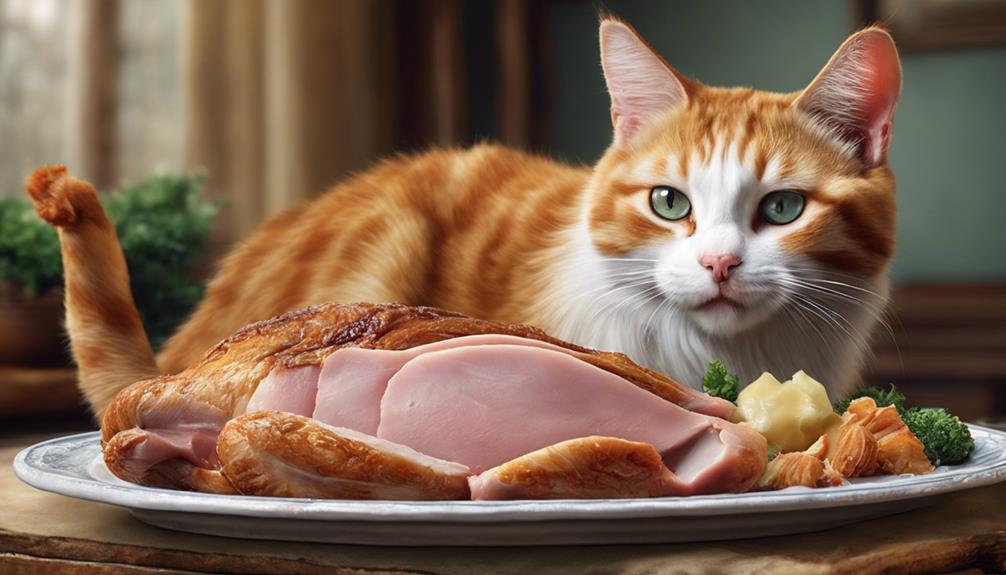
Experiencing allergic reactions to turkey can pose serious health risks for cats. Just like humans, our feline friends can develop food allergies, with symptoms ranging from itching, redness, and swelling to vomiting and diarrhea. These reactions may be a result of their immune system identifying turkey proteins as harmful invaders, leading to skin problems or digestive issues.
If you notice any signs of an allergic reaction in your cat after consuming turkey, it's essential to seek vet consultation promptly. Your veterinarian can help determine the specific allergens causing the reactions through food trials, allowing for better management of your cat's dietary needs.
Turkey Induced Sleepiness
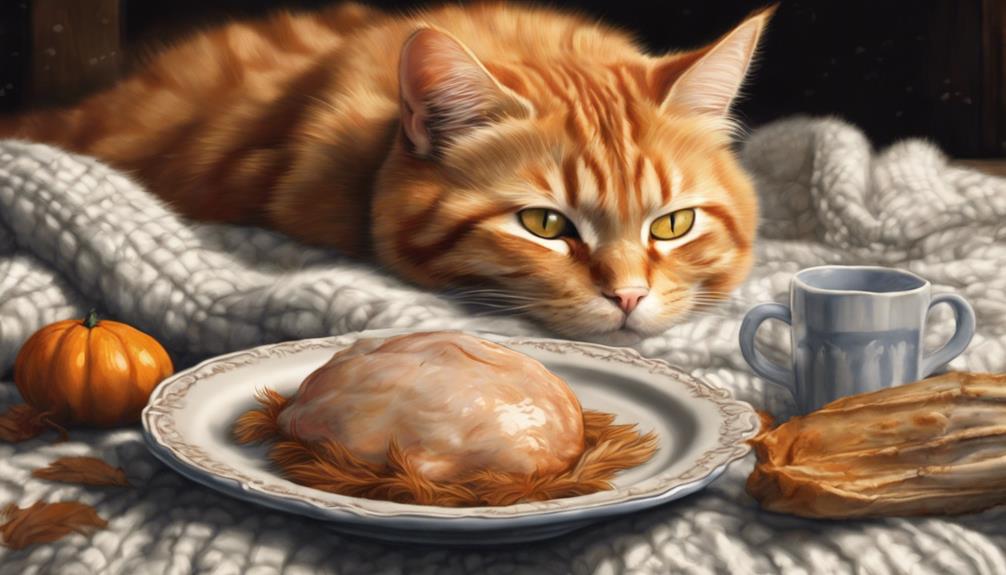
Consuming small amounts of cooked turkey is unlikely to induce sleepiness in cats due to the minimal effect of the amino acid tryptophan present. While tryptophan in turkey may mildly calm cats, it doesn't lead to significant drowsiness.
Here are four key points to take into account regarding turkey-induced sleepiness in felines:
- Tryptophan Content: Turkey does contain tryptophan, but the levels aren't substantial enough to cause noticeable sleepiness in cats.
- Minimal Effect: The calming effect of tryptophan in turkey is minimal and not potent enough to induce significant drowsiness in feline companions.
- Taurine Production: Cats naturally synthesize taurine from proteins like turkey, which is essential for their health and not associated with inducing sleepiness.
- Mythical Nature: The idea of turkey-induced sleepiness is a common myth among humans and doesn't directly apply to cats' metabolism.
Deli Turkey Concerns
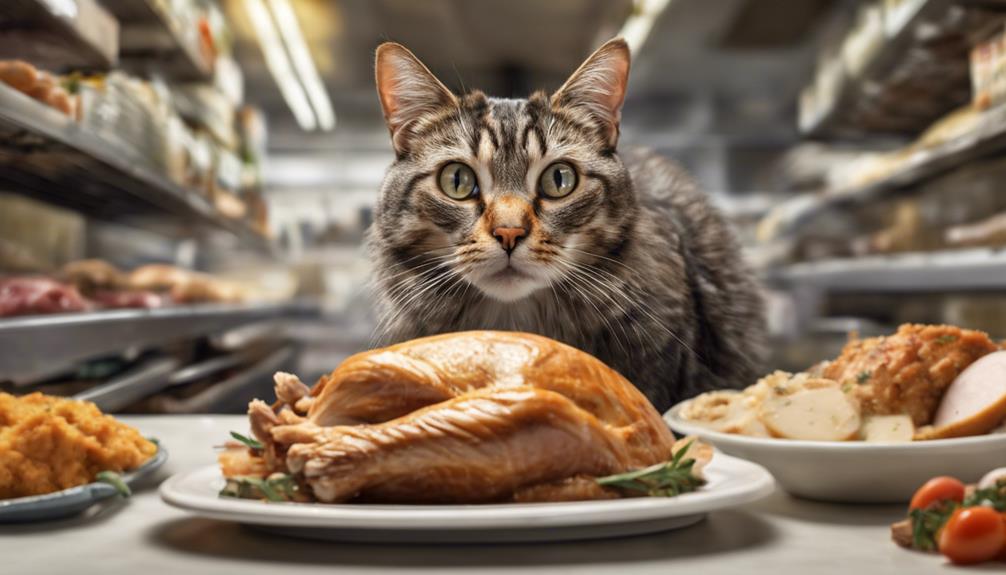
Avoiding deli turkey is crucial for cats due to its high sodium and harmful additives that can be detrimental to their health. Processed deli turkey often contains nitrates and other additives that aren't recommended for our feline friends. The sodium content in deli turkey is much higher than what cats should consume, leading to potential health issues if ingested regularly. While a small bite mightn't cause immediate harm, it's best to steer clear of offering deli turkey as a treat to your beloved cat.
Opting for plain, cooked ground turkey is a safer alternative for cats compared to processed deli turkey. Homemade plain cooked turkey patties can be a healthier and more wholesome treat option for your cat. By avoiding deli turkey and opting for simpler, less processed options, you can guarantee that your cat enjoys their turkey treat without any potential harm from excessive sodium or harmful additives.
Turkey Bones Caution
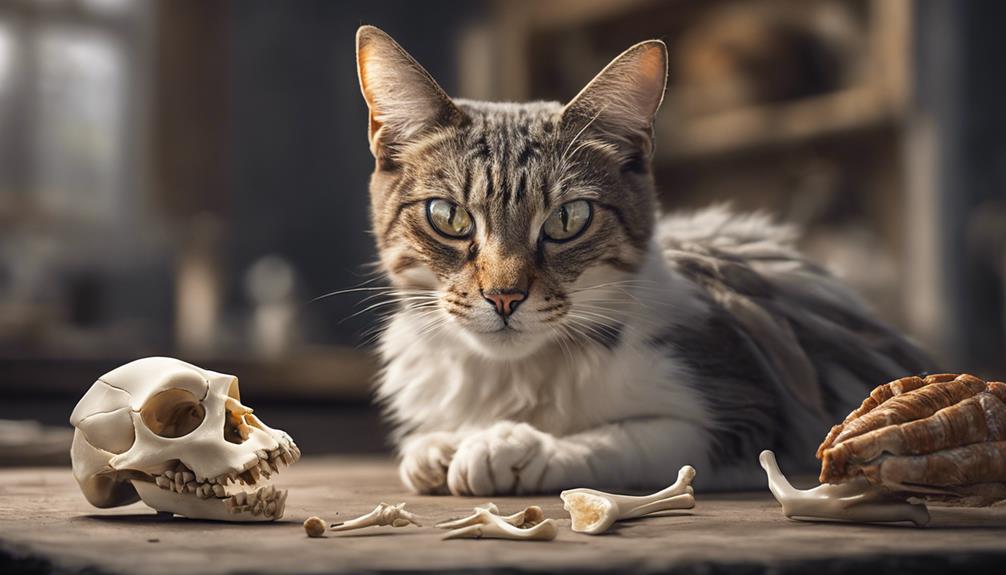
When providing turkey to cats, it's essential to eliminate all bones to prevent potential choking hazards and injuries. Here are some important points to keep in mind:
- Choking Hazards: Turkey bones can easily splinter, posing a risk of choking if swallowed by cats.
- Injuries in the Mouth: Sharp bone fragments can cause cuts and harm in the mouth of cats while consuming turkey.
- Organ Damage: If consumed, bones can puncture the esophagus or intestines, leading to serious internal injuries.
- Precaution: Always make sure that any turkey meat offered to cats is bone-free to avoid any harm or discomfort.
It's vital to prioritize the safety and well-being of our feline companions by being mindful of the potential dangers associated with turkey bones. By taking a few extra moments to remove bones before serving turkey, we can help keep our cats safe and healthy during mealtime.
Turkey Bacon for Cats

Turkey bacon poses health risks for cats due to its high salt, preservatives, and fat content, making it an unsuitable treat option. While cats eat turkey as part of their diet, turkey bacon is a different story. The added salt and preservatives in turkey bacon can be harmful to our feline friends, potentially leading to health issues if consumed regularly.
Instead of risking their well-being, opt for plain, cooked turkey as a safer alternative. Cats can enjoy the goodness of cooked turkey without the unhealthy extras found in processed turkey bacon. By offering plain, cooked turkey, you provide a tasty treat that's less likely to upset their delicate systems.
Safe Turkey Feeding Practices

After considering the risks of offering turkey bacon to cats, focusing on safe turkey feeding practices becomes crucial to guarantee our feline friends' well-being. When it comes to feeding your cat turkey, it's vital to follow these best practices for pet health:
- Limit Treats: Treats shouldn't make up more than 10% of your cat's daily calorie intake when feeding them turkey.
- Watch the Skin: Be cautious with turkey skin as it's high in fat, so it's best to avoid giving large amounts to your cat.
- Consult a Vet: If your cat consumes significant quantities of turkey, consulting a vet can ensure it's safe for them.
- Stick to Plain Turkey: Feed your cat plain, cooked turkey without any spices or seasonings to maintain their well-being.
Monitoring Turkey Consumption
Monitoring your cat's turkey intake is crucial to guarantee their dietary balance and overall health. To make sure your feline friend maintains a balanced diet, it's important to keep track of how much turkey they're consuming.
Limit their turkey consumption to no more than 10% of their daily calorie intake, as exceeding this amount could lead to nutritional imbalances. When offering turkey treats, stick to 2-3 thumbnail-sized pieces once or twice a week.
If you notice that turkey treats are becoming a significant part of your cat's diet, it's advisable to consult with a vet for guidance on how to adjust their feeding routine. Be cautious of seasoned, processed, or dark meat turkey, as these may not be suitable for your cat's consumption.
Always prioritize your cat's well-being by ensuring that any turkey treats given to them are safe and healthy. By monitoring your cat's turkey consumption closely, you can help them maintain a healthy and balanced diet.
Frequently Asked Questions
Is Chicken or Turkey Better for Cats?
We believe chicken is better for cats due to its lower fat content. While turkey can be safe in moderation, chicken's lean protein is easier to digest. When choosing between the two, chicken is often preferred.
Can I Give My Cat Turkey Lunch Meat?
We should avoid giving our cats turkey lunch meat due to its high sodium and potential additives. Opt for plain, cooked white meat turkey as a safer alternative. Always consult with a vet before introducing new foods to our feline friends.
Can I Feed My Cat Turkey Giblets?
We love giving our cats turkey giblets as a treat. It's crucial to cook them thoroughly and avoid seasonings. Moderation is key to prevent tummy troubles. Checking with a vet beforehand guarantees it's safe for your fur baby.
Can Cats Eat Turkey Heart and Liver?
Turkey heart and liver are safe for cats in small amounts. These organ meats are packed with essential nutrients. Remember, moderation is key. Consult your vet to determine the right serving size for your cat.
Conclusion
To sum up, while cats can enjoy turkey in moderation, it's important to be mindful of certain dangers such as bones and seasonings. By sticking to plain, cooked turkey and monitoring their intake, you can safely treat your feline friend to a tasty snack.
Remember, a little turkey goes a long way in keeping your cat happy and healthy! Just like Thanksgiving leftovers, it's all about balance and moderation.
Paul’s love for animals knows no bounds. As a dedicated writer and animal lover, Paul brings a unique perspective to our team. His firsthand experiences with various animals enrich our content and provide valuable insights into their behavior and needs. Whether he’s sharing tips for pet care or shedding light on pressing conservation issues, Paul’s passion for animals shines through in everything he does.
Cats
The Ultimate Roundworm Treatment Guide for Cats
In-depth insights on roundworm treatment for cats, including deworming schedules and natural remedies, await in this comprehensive guide.
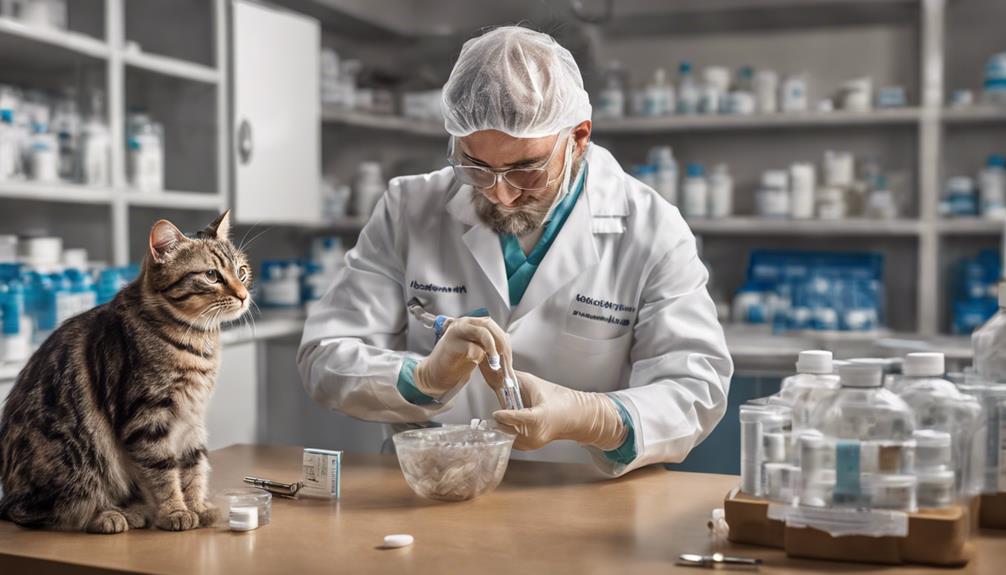
When it comes to roundworm treatment for cats, a holistic approach is key. Regular deworming, personalized medications, and preventative steps are essential for managing these infections and ensuring our furry friends' well-being. Understanding symptoms, outdoor risks, and consulting with vets for tailored plans are important. Setting up a deworming schedule, using common treatments like Pyrantel Pamoate, and considering natural remedies can aid in combating roundworms. Don't forget to seek advice from professionals for personalized guidance. A complete strategy is necessary in fighting roundworms effectively and safeguarding your cat's health for the long haul.
Key Takeaways
- Consult a vet for accurate diagnosis and tailored treatment plans.
- Follow a deworming schedule for kittens and adult cats.
- Use Pyrantel Pamoate or Panacur/Fenbendazole for treatment.
- Monitor progress and maintain homecare during treatment.
- Consider natural remedies like pumpkin seeds under veterinary guidance.
Understanding Roundworms in Cats
Roundworms infest cats due to their exposure to common intestinal parasites Toxocara cati and Toxascara leonina, which can reach lengths of up to 4 inches and are typically white to light brown. These pesky parasites are a common threat to our feline friends, lurking in the environment and waiting to infect unsuspecting cats. It's essential to understand the risks associated with roundworms in cats to protect our beloved pets from potential harm.
These roundworms can easily find their way into our cats through various means, such as contact with infected animals, contaminated soil, or even through the milk of infected mothers. Once inside our cats, these parasites can wreak havoc on their delicate systems, causing symptoms like vomiting, diarrhea, weight loss, coughing, and respiratory issues. By knowing how roundworms operate and the ways they can enter our cats' bodies, we can take proactive steps to prevent and treat these infections effectively.
Let's dive deeper into the world of roundworms and equip ourselves with the knowledge needed to keep our feline companions healthy and happy.
Recognizing Symptoms of Roundworm Infection
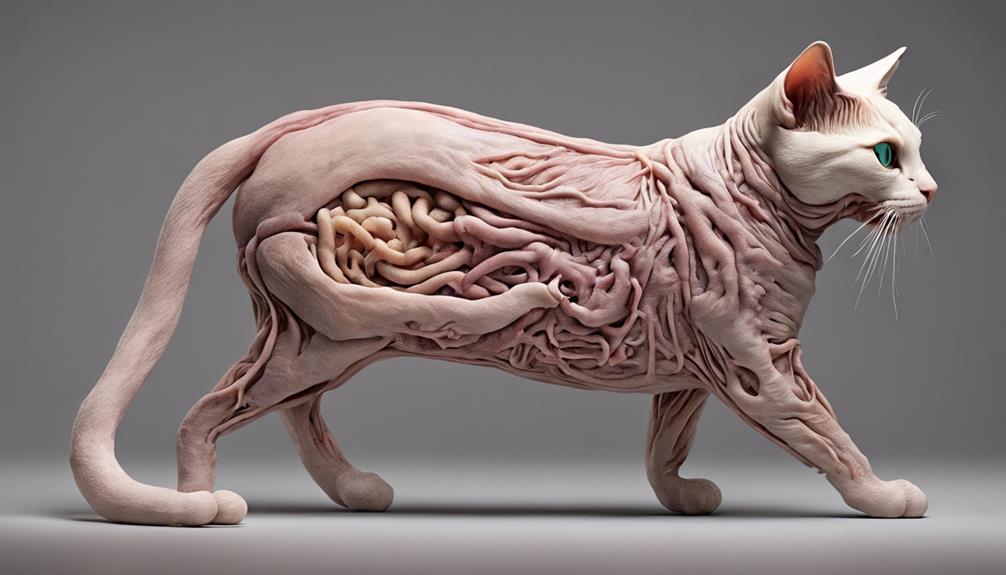
As responsible cat owners, we must be vigilant in recognizing the symptoms of roundworm infection in our feline companions. Common signs to watch out for include vomiting, diarrhea, weight loss, and coughing.
Kittens may also exhibit poor growth, a bloated abdomen, and increased vocalization, while adult cats might show dull coats, lethargy, and a decreased appetite.
Common Roundworm Symptoms
How can you easily identify the symptoms of roundworm infection in cats?
When it comes to roundworms, kittens often show signs like vomiting, diarrhea, weight loss, and a bloated belly. Keep an eye out for these indicators, especially in young cats.
In adult felines, symptoms may include diarrhea, weight loss, a lackluster coat, vomiting, and even coughing. Severe infections with a high number of roundworms could lead to intestinal blockages, posing a serious threat to your furry friend's health.
Behavioral Changes in Cats
When cats are infected with roundworms, their behavior may undergo noticeable changes, including increased appetite. Cats may exhibit signs like itching or scooting their bottom on the floor, indicating discomfort from the roundworm infection.
Additionally, weakness and lethargy could be observed in infected cats as a symptom of the condition. Vomiting and diarrhea are common behavioral symptoms that indicate a potential roundworm infection in cats.
Keep an eye out for kittens with roundworms, as they may display an enlarged abdomen, giving them a pot-bellied appearance.
Recognizing these behavioral changes is pivotal in identifying and treating roundworm infections promptly to safeguard the well-being of your feline companions.
Risks of Outdoor Activities for Cats
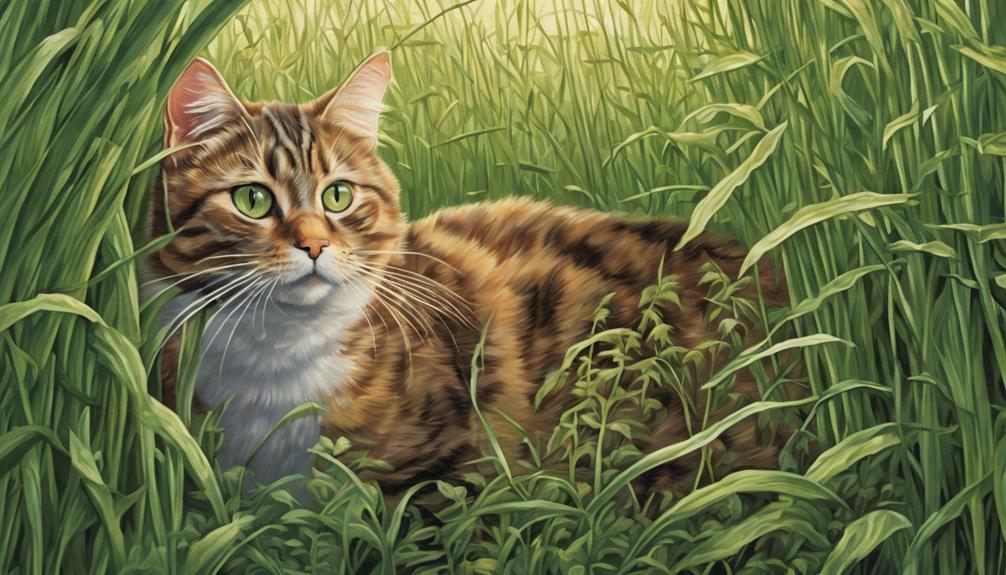
Engaging in outdoor activities exposes cats to various risks, including the potential ingestion of roundworm eggs from soil or infected prey. Here are three key risks to keep in mind:
- Contaminated Environments: Cats can easily pick up roundworms by encountering contaminated feces in outdoor areas. It's important to be vigilant and prevent cats from exploring areas where infected animals may have defecated.
- Hunting Behavior: Cats' natural instinct to hunt birds and rodents outdoors can lead to exposure to roundworms. These small prey animals can carry roundworms, increasing the risk of infection for outdoor cats.
- Interactions with Wildlife: Infected wildlife and stray cats can also contribute to the transmission of roundworms in outdoor environments. Cats that roam freely outdoors are more likely to come into contact with these sources of infection.
To safeguard your feline companions, regular deworming and preventive measures are vital for outdoor cats to minimize the risk of roundworm infections.
Importance of Veterinary Consultations

Exploring the risks associated with outdoor activities for cats underscores the important role of veterinary consultations in managing and preventing roundworm infections. Veterinary consultations are vital for accurate diagnosis and treatment plans tailored to your cat's specific needs. Vets offer expert advice on deworming schedules, medications, and preventive measures, ensuring your cat receives the best care possible.
Regular check-ups with a vet are essential for monitoring your cat's response to treatment and making any necessary adjustments. Veterinarians have the expertise to detect any underlying health issues or complications related to roundworm infections in cats, providing thorough care that goes beyond just treating the symptoms.
Trusting in veterinary consultations is key to ensuring the safe and effective use of deworming products for your beloved feline friend. By working closely with your vet, you can safeguard your cat's health and well-being against the dangers of roundworm infestations.
Establishing a Worming Prevention Schedule

Developing a consistent worming schedule is vital for safeguarding your cat's health against roundworm infections. To make sure your feline friend stays protected, here are some key tips to establish a regular deworming routine:
- Kittens require more frequent deworming: Kittens should undergo deworming every 2 weeks until they reach 16 weeks of age. This frequent treatment helps prevent roundworm infections during their vulnerable early stages of life.
- Adult cats benefit from periodic deworming: Even after the kitten stage, regular deworming remains essential. Adult cats should be dewormed every few months to maintain a healthy worming prevention schedule and keep them protected from roundworms.
- Consult your vet for personalized guidance: Each cat is unique, and factors like age and lifestyle play a role in determining the ideal deworming schedule. Consulting with your vet ensures you receive tailored advice on the best approach to protect your cat from roundworm infection.
Signs of Roundworm Infestation in Cats
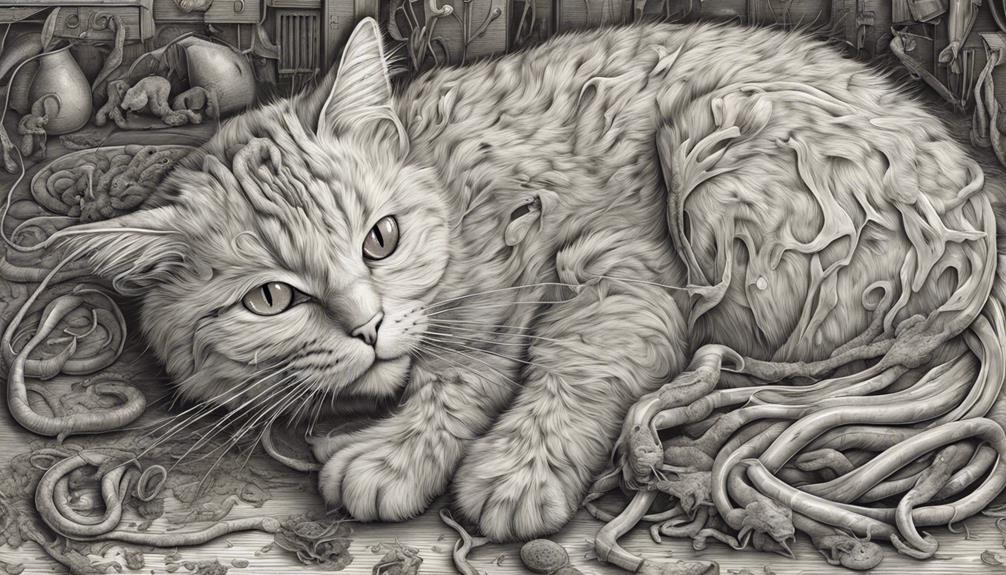
As cat owners, recognizing the signs of roundworm infestation in our feline companions is vital. Symptoms like vomiting, diarrhea, weight loss, and a pot-bellied appearance are common indicators of roundworms in cats.
Keep an eye out for these behavioral changes, as early detection can make a significant difference in your cat's health and well-being.
Common Symptoms in Cats
Symptoms of roundworm infestation in cats commonly include weight loss, increased appetite, itchy bottom, weakness, dull coat, vomiting, and an enlarged abdomen, particularly noticeable in kittens. When suspecting roundworms, keep an eye out for these signs:
- Weight Loss: Your feline friend may start shedding pounds unexpectedly.
- Increased Appetite: Despite eating more, your cat might seem to be losing weight.
- Itchy Bottom and Weakness: Watch for any signs of discomfort or lack of energy in your furry companion.
Keeping a close watch on these symptoms can help you identify a potential roundworm infestation in your beloved cat. If you notice any of these signs, consulting with your veterinarian for proper diagnosis and treatment is crucial.
Behavioral Changes Observed
Observing behavioral changes in your cat can provide valuable clues indicating a possible roundworm infestation. Cats with roundworms may show increased appetite despite weight loss, a sign that the worms are stealing essential nutrients.
If you notice your cat itching or scooting its bottom on the ground, it could be a behavioral sign of roundworms. Weakness and a dull, dry coat are common behavioral symptoms that may suggest a roundworm infestation.
Keep an eye out for vomiting and diarrhea, as these could be indicators of potential roundworm infestations in cats. For kittens, an enlarged abdomen compared to their body size could be a visible sign of roundworms.
If you suspect your cat has roundworms, consult your veterinarian for proper diagnosis and treatment.
Treating Roundworm Infections in Cats
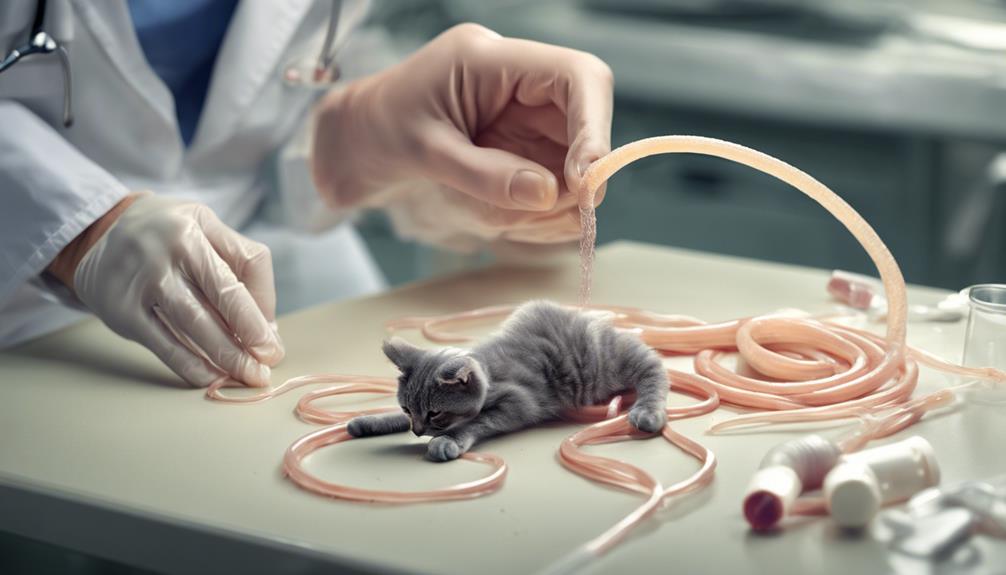
To effectively combat roundworm infections in cats, a combination of oral and topical medications is commonly prescribed. This treatment approach targets the intestinal parasites at various stages of their life cycle, ensuring a more thorough elimination process.
Here are three key points to contemplate when treating roundworm infections in cats:
- Follow the Treatment Schedule: Administering multiple doses of medication on a prescribed schedule is vital. This helps target all life stages of the roundworms, enhancing the effectiveness of the treatment.
- Monitor Progress: Keep a close eye on your cat's stool during and after treatment. Consecutive tests can help verify that the parasites are being eliminated successfully. Early detection of any issues allows for prompt adjustments to the treatment plan.
- Maintain Homecare: Implement proper homecare management during and post-treatment. Regularly clean the litter box to prevent re-infection and limit your cat's outdoor exposure to reduce the risk of contracting roundworms again. Consistent care is essential for your cat's overall health and well-being.
Special Considerations for Kittens
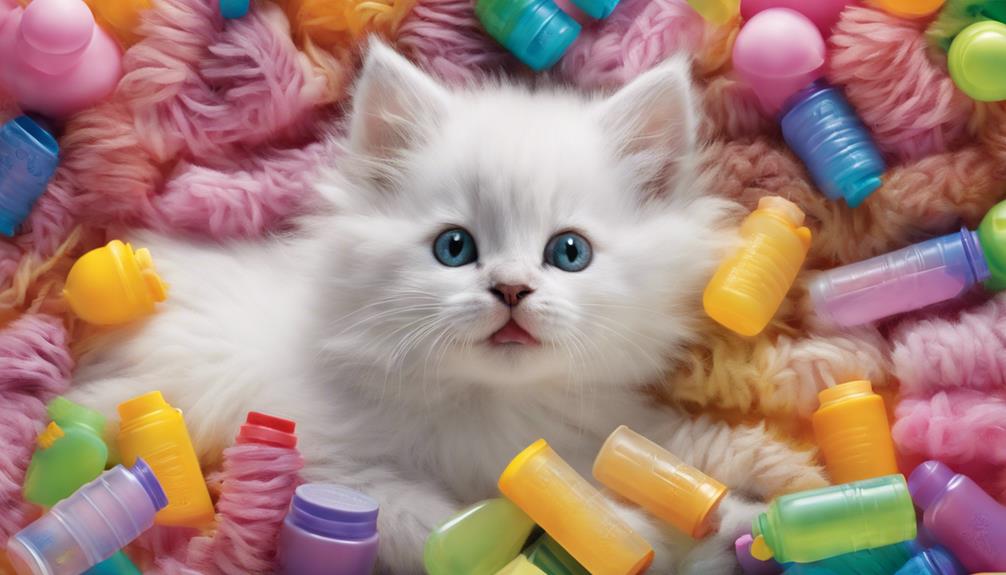
Kittens require special attention when it comes to roundworm treatment. Due to their vulnerable immune systems, they're more prone to infections.
Ensuring the accurate dosage based on their weight is essential for their health.
Kitten Weight Requirements
Starting at 4 weeks of age, young felines should be given deworming medication based on their body weight to guarantee proper care and development. Here are some essential points to take into account when deworming kittens:
- Weight-Based Dosage: The recommended dosage for kittens is 0.1 ml per pound of body weight. Ensuring the accurate dosage based on weight is critical for the effectiveness of the treatment.
- Frequency of Deworming: Deworming should be repeated every 2 weeks until kittens reach 16 weeks of age. This schedule helps address any potential reinfestation and ensures the kittens grow up healthy and strong.
- Preventative Measure: Regular deworming plays a crucial role in preventing the spread of roundworms in kittens, safeguarding their health and overall well-being.
Kitten Dosage Adjustments
Considering the unique needs of young felines, dosage adjustments for deworming treatments in kittens are essential for their well-being and safety. Kittens, due to their smaller size and developing immune systems, require special considerations when it comes to dosing dewormers.
The dosage is typically adjusted based on their weight to guarantee the treatment's effectiveness and safety. Following the recommended guidelines is important to prevent the risks of under or overdosing in kittens. These little ones may need more frequent deworming compared to adult cats, given their susceptibility to roundworms.
It's highly recommended to consult a veterinarian for proper dosing instructions and to schedule deworming treatments to keep your kittens healthy and free from parasites.
Prevention Methods for Roundworms

Regular deworming every few months is an essential preventive measure for ensuring cats remain free from roundworm infections. Here are three practical ways to help prevent roundworms in your feline friends:
- Maintain a Regular Deworming Schedule: Consistency is key when it comes to keeping roundworms at bay. By following a routine deworming schedule recommended by your veterinarian, you can help protect your cat from these pesky parasites.
- Keep Your Cat's Living Environment Clean: Regularly cleaning your cat's litter box and living area can help reduce the risk of roundworm transmission. Roundworm eggs can survive in the environment for extended periods, so maintaining cleanliness is vital.
- Prevent Hunting and Roaming: If your cat has outdoor access, try to limit their hunting activities to prevent them from ingesting prey that may be infected with roundworms. Keeping your cat indoors or supervising outdoor adventures can help lower the risk of exposure to these parasites.
Benefits of Consulting a Veterinarian

For important care and personalized treatment plans for roundworm infections in cats, seeking advice from a veterinarian is essential. Veterinarians possess the expertise to accurately diagnose roundworm infections in cats through fecal tests.
By consulting a veterinarian, cat owners guarantee that their feline companions receive appropriate and effective treatment plans tailored to eliminate roundworms effectively. Vets can recommend the most suitable deworming medications and dosages based on factors such as the cat's age, weight, and health status.
Additionally, professional guidance from a veterinarian is invaluable in monitoring the cat's progress during and after the treatment for roundworms, ensuring the best possible outcome.
In addition, veterinarians play a vital role in educating cat owners about preventive measures to avoid future roundworm infestations, empowering them to provide the best care for their beloved pets.
Hence, when it comes to treating roundworms in cats, consulting a veterinarian is the ideal choice for thorough and effective care.
Roundworm Treatment for Developing Immune Systems

When addressing roundworm treatment for developing immune systems in kittens, timely intervention is essential to safeguard their health and well-being. Here are three essential points to take into account:
- Critical Detection: Due to their underdeveloped immune systems, kittens are more vulnerable to roundworm infections. Regular check-ups with a veterinarian can help identify any signs of roundworm infestations early on, ensuring prompt treatment.
- Consistent Deworming: Young kittens can acquire roundworms from their mother's milk, underscoring the importance of consistent deworming schedules. Following a deworming regimen recommended by a veterinarian is pivotal to preventing complications and supporting the development of their immune systems.
- Special Care: Developing immune systems in kittens require extra care when it comes to roundworm treatment. Ensuring they receive the appropriate medication in the correct dosage and following up with vet visits for monitoring and adjustments is crucial to their overall health and well-being.
Common Treatments for Roundworms in Cats
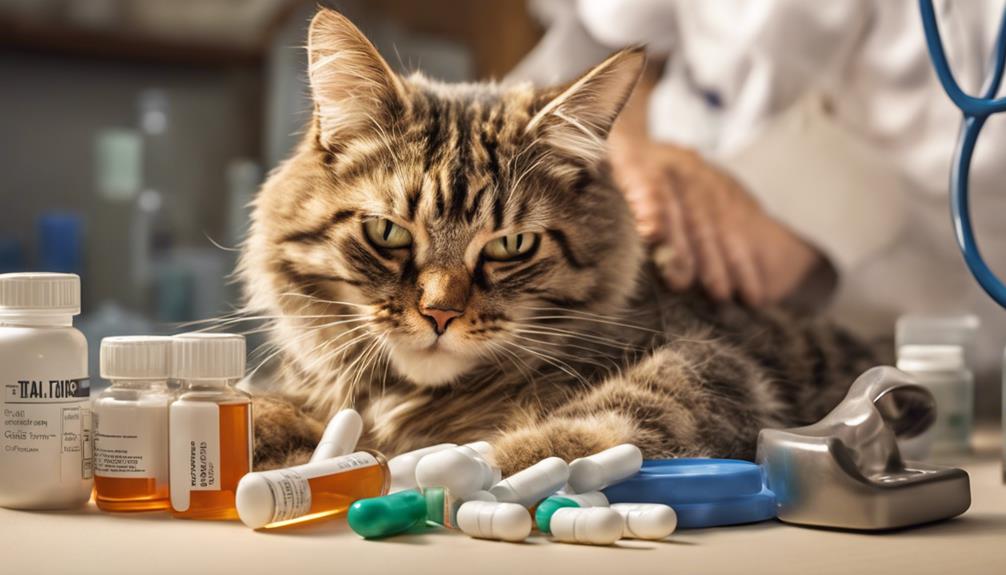
When treating roundworms in cats, there are common medications available, such as Pyrantel Pamoate and Panacur/Fenbendazole.
These treatments are effective against various parasites and have specific dosages based on the cat's weight.
Regular deworming using these options is essential to keep cats protected from roundworm infections.
Medication Options
In treating roundworms in cats, we commonly rely on effective medications such as Pyrantel Pamoate and Panacur/Fenbendazole. These medications play a vital role in eliminating these pesky parasites from our furry friends. Here are some key points to keep in mind:
- Pyrantel Pamoate: Safe for young kittens and pregnant queens, this medication is a go-to for treating roundworms. Remember to administer 0.1 ml per pound based on weight.
- Panacur/Fenbendazole: Effective against various worms and Giardia, this medication requires 3-5 consecutive days of treatment. The dosage is 0.2 ml per pound, with specific amounts based on your cat's weight.
- Regular Deworming: Consistent use of these medications every 2 weeks for kittens until 16 weeks helps prevent and manage roundworm infections, ensuring our cats stay healthy and happy.
Natural Remedies
Let's explore the effectiveness of natural remedies in treating roundworms in cats. Natural remedies like pumpkin seeds, diatomaceous earth, and apple cider vinegar can help combat roundworms in your feline friend. Here's a handy table to showcase these remedies:
| Natural Remedy | How it Works | Considerations |
|---|---|---|
| Pumpkin Seeds | Contains cucurbitacin, paralyzing and eliminating worms | Use with caution |
| Diatomaceous Earth | Dehydrates and kills roundworms in cats | Ensure food-grade quality |
| Apple Cider Vinegar | Creates an inhospitable environment for roundworms in the digestive tract | Dilute before administering |
Frequency of Worming Treatments
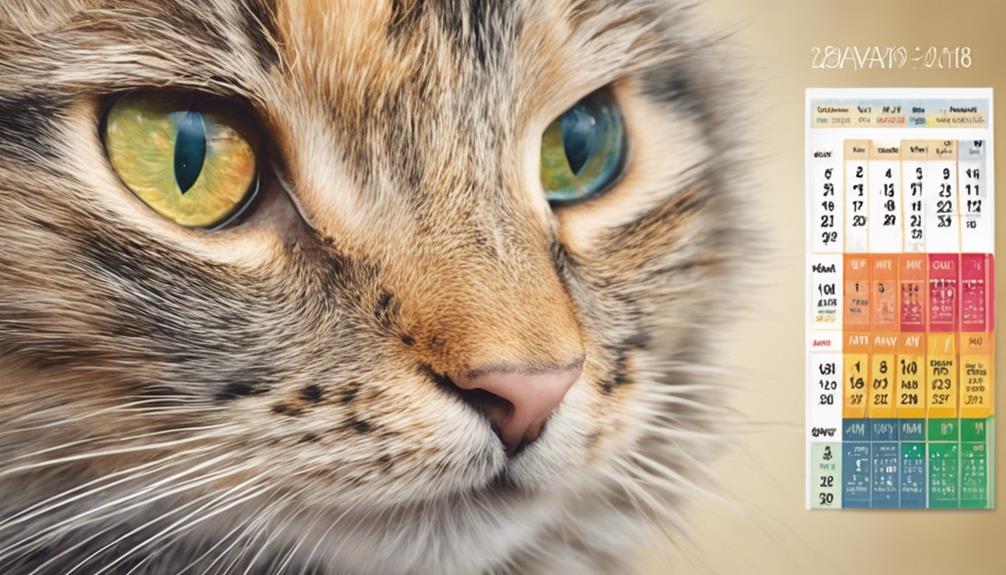
To effectively prevent roundworm infections in cats, it's important to establish a consistent deworming schedule tailored to the specific needs of your feline companion. Here are three essential points to keep in mind when determining the frequency of worming treatments:
- Kittens require more frequent deworming: Young kittens are more susceptible to roundworms and should be dewormed every 2 weeks until they reach 16 weeks of age. This helps prevent and control infestations at an early stage when they're most vulnerable.
- Regular deworming for adult cats: Once your cat reaches adulthood, it's recommended to continue with regular deworming treatments every few months. This routine helps maintain a healthy and worm-free environment for your furry friend.
- Consult your veterinarian: Every cat is unique, and their deworming needs may vary based on factors like age, health status, and lifestyle. Seeking advice from your veterinarian for personalized guidance on the ideal deworming frequency for your cat is essential in effectively managing roundworm infections.
Personalized Guidance From Veterinarians

Veterinarians offer tailored guidance on effective roundworm treatment options for cats based on individual factors like weight and health status. When it comes to treating roundworms in your feline companion, consulting with a vet is essential to guarantee the right approach. The dosage and duration of treatment can vary depending on the severity of the infestation, so personalized advice from a professional is key.
Expert Advice on Roundworm Prevention
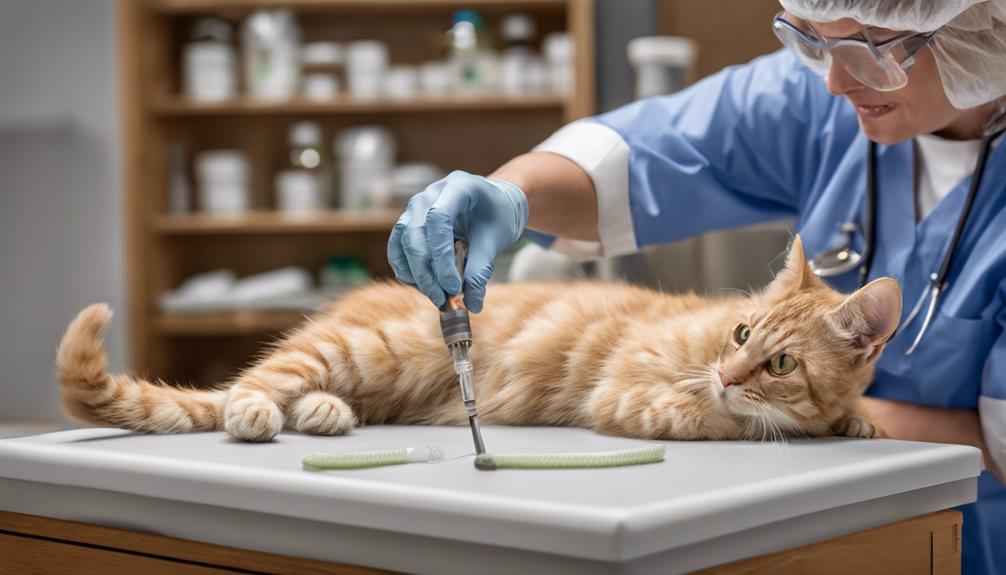
Seeking expert guidance on preventing roundworm infections is vital for maintaining your cat's health and well-being. Here are three essential tips to help you prevent roundworm infestations in your feline friend:
- Regular Deworming: Make sure to deworm your cat every few months as recommended by your veterinarian. Regular deworming is essential in preventing roundworm infections and keeping your cat healthy.
- Higher Risk for Kittens: Keep in mind that kittens are at a higher risk of roundworm infections due to their immature immune systems. It's important to start deworming them early and follow a consistent deworming schedule.
- Consult Your Veterinarian: Establishing a consistent and regular worming routine for your cat is crucial. Consult your veterinarian for the best prevention and treatment plan tailored to your cat's specific needs. Utilize resources like 'Find a Vet' or 'Online Vets' to seek expert advice on roundworm prevention for your cat. Remember, prevention is key to keeping your cat healthy and happy.
Frequently Asked Questions
What Is the Best Treatment for Roundworms in Cats?
The best treatment for roundworms in cats is Pyrantel Pamoate or Fenbendazole (Panacur). Pyrantel Pamoate is safe for kittens and pregnant queens, while Panacur treats various parasites. Regular deworming is important for preventing and treating roundworm infections.
How Long Does Roundworm Dewormer Take to Work on Cats?
Roundworm dewormer typically starts working in cats within 24-48 hours. The efficacy varies based on the product and the cat's response. Dead worms may pass in stool post-treatment. Complete elimination can take days to a week.
How Many Doses Does It Take to Get Rid of Worms in Cats?
To completely eliminate worms in cats, it usually takes multiple doses of deworming medication. The required number of doses varies based on the worm type and severity. Consult your vet for personalized guidance on treatment duration.
How Do You Clean Your House After a Cat Has Roundworms?
After a cat has roundworms, we clean our house by vacuuming carpets and furniture, disinfecting surfaces, washing bedding and toys in hot water, promptly disposing of feces, and avoiding soil contact. Our vet provides tailored cleaning recommendations.
Conclusion
To sum up, taking proactive steps to prevent and treat roundworm infections in cats is essential for their health and well-being. By collaborating closely with your veterinarian, establishing a regular worming schedule, and staying informed about the risks of outdoor activities, you can help keep your feline friend safe and healthy.
Remember, a little prevention can go a long way in ensuring your cat's happiness and longevity. Just ask Fluffy, who enjoys her outdoor adventures without the worry of pesky parasites.
Paul’s love for animals knows no bounds. As a dedicated writer and animal lover, Paul brings a unique perspective to our team. His firsthand experiences with various animals enrich our content and provide valuable insights into their behavior and needs. Whether he’s sharing tips for pet care or shedding light on pressing conservation issues, Paul’s passion for animals shines through in everything he does.
Cats
What Causes Cats Ears to Feel Hot?
Get insights into why cats' ears feel hot, from heat regulation to allergies and ear conditions, to ensure your feline's well-being.
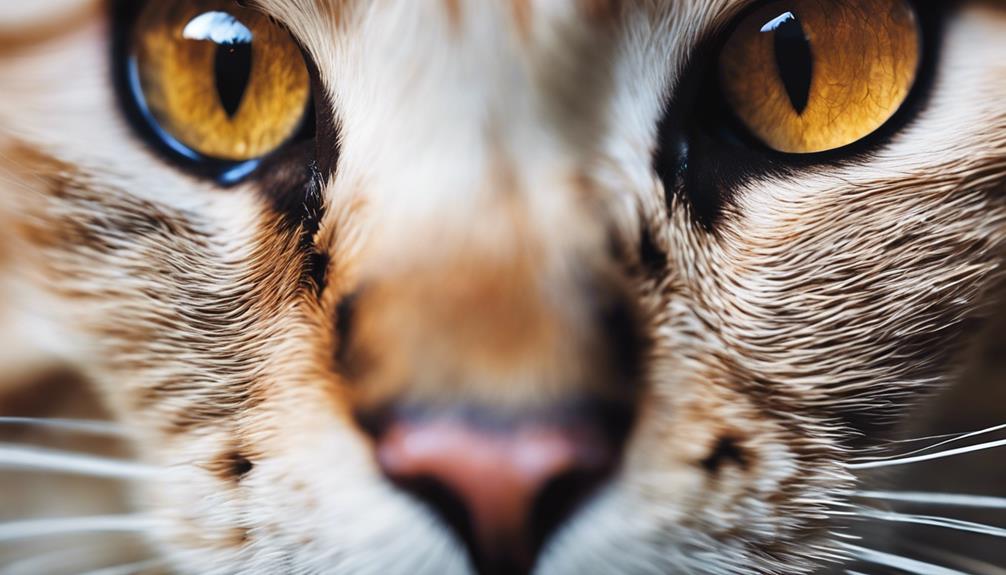
Cats' ears can feel hot as they regulate body temperature by increasing blood flow. This warmth often indicates a response to heat, allergies, fever, or ear conditions. Cats naturally manage hot weather by increasing blood flow to their ears, paws, and nose, helping release excess heat. Allergic reactions, fever, and specific ear issues can also lead to warm ears in cats. Monitoring your feline's well-being is important, especially if accompanied by unusual symptoms. Understanding these causes can help you better care for your pet's health and comfort. Further insights into cat ear conditions and temperature management are essential for responsible pet ownership.
Key Takeaways
- Cats regulate body temperature by increasing blood flow to ears.
- Warm ears indicate a response to excess heat.
- Monitoring ear warmth can reflect overall well-being.
- Hot ears in cats are common in hot weather.
- Consult a vet if hot ears are accompanied by unusual symptoms.
Normal Ear Temperature Regulation
When cats regulate their body temperature, they increase blood flow to their ears. This clever mechanism helps our feline friends release excess heat, especially during warmer days. So, if you've ever felt your cat's ears and noticed they were a bit warm, don't worry – it's a normal response to temperature changes. Those toasty ears are actually a sign that your cat's body is working hard to stay cool and comfortable.
Monitoring your cat's ears for warmth is a good way to keep an eye on their overall well-being. Warm ears are usually nothing to be concerned about, but if you notice other unusual symptoms along with the warmth, it might be a good idea to consult with your vet. By paying attention to these little cues, we can help our cats stay healthy and happy, even when they're trying to beat the heat with their adorable, warm ears.
Cats Response to Hot Weather

When the weather gets hot, cats have some clever ways to stay cool.
They increase blood flow to their ears, paws, and nose, allowing them to release excess heat.
Cats Heat Regulation
Cats efficiently regulate their body temperature by increasing blood flow to their ears, nose, and paws in response to hot weather. When you notice your kitty's ears feeling warm, it's their way of releasing excess heat and preventing overheating. Those toasty ears are a natural response to keep their body temperature in check.
To help your feline friend stay cool during hot weather, provide shade, plenty of water, and lend a hand with grooming. By ensuring these simple measures, you can assist your cat in managing the heat and keeping their ears at a comfortable temperature.
Sun Exposure Effects
In scorching weather, feline companions respond to sun exposure by utilizing their ears, paws, and nose to regulate body temperature efficiently. When cats are exposed to the sun's rays, their ears may feel warm as increased blood flow helps release excess heat from their bodies. This natural response aids in cooling them down during hot weather. Providing shade, water, and grooming assistance can further assist cats in managing their body temperature. Here is a helpful table to understand how cats respond to sun exposure:
| Response | Description |
|---|---|
| Warm Ears | Increased blood flow aids in heat release |
| Paws and Nose | Also involved in regulating body heat |
| Grooming Assistance | Helps cats cool down and maintain comfort |
Behavior in Heat
Responding to high temperatures, feline companions exhibit distinct behaviors to cope with the heat and regulate their body temperature efficiently. Cats regulate their body temperature by increasing blood flow to their ears, paws, and nose when the weather gets hot. This increased blood flow helps them release excess heat, and you might notice their ears feeling warm. It's a vital response to aid in cooling their bodies.
To help your cat stay cool and prevent overheating during hot weather, provide shade, plenty of water, and grooming assistance. Monitoring your cat's behavior is essential, as extreme heat can be dangerous for them. By understanding their cooling mechanisms and taking proper care, you can make sure your furry friend stays comfortable even in the hottest weather.
Allergic Reactions and Hot Ears
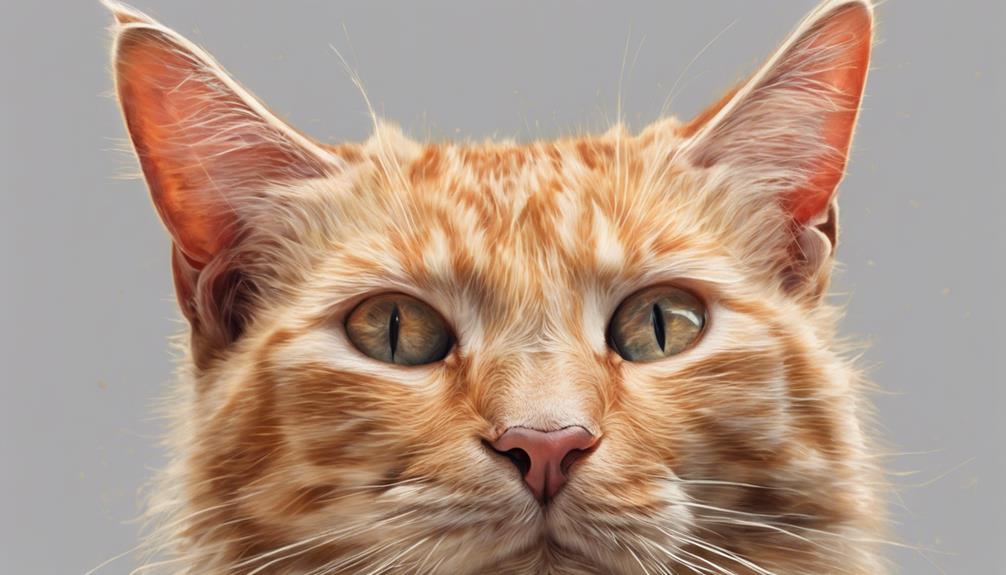
Experiencing allergic reactions can often result in cats having hot ears as a noticeable symptom. When our furry friends come into contact with allergens like pollen or grass, their immune system can react, leading to symptoms such as bloating, sneezing, and those telltale hot ears. If you notice your cat's ears feeling warm, it could be a sign of an allergic reaction. Fortunately, allergy testing can pinpoint the specific allergen triggering this response, helping us find effective solutions for managing hot ears in cats.
To provide clarity on allergic reactions and hot ears in cats, here is a helpful table outlining key points:
| Topic | Description | Importance |
|---|---|---|
| Allergens | Pollen, grass, insects, certain foods | Identifying triggers |
| Symptoms | Bloating, sneezing, hot ears | Indicating allergies |
| Allergy Testing | Pinpoint specific allergen causing hot ears | Tailored treatment |
Understanding these aspects can assist in addressing allergic reactions and keeping our feline companions comfortable and healthy.
Fever Indications in Cats

After discussing how hot ears in cats can be a sign of allergic reactions, we now shift our focus to identifying fever indications in felines. Fever in cats is often accompanied by a range of symptoms that can help you recognize when your furry friend might be feeling under the weather. Signs of fever include lethargy, reduced appetite, and behavioral changes.
If you suspect your cat might've a fever, it's crucial to check their temperature. Using a rectal thermometer is the most accurate way to measure a cat's temperature, as their ears feeling warm alone may not provide an accurate reading. Remember, a cat's normal temperature ranges from 101° to 102.5°F.
If your cat's temperature is persistently above 104°F, seek immediate veterinary care to address any underlying issues. Keeping an eye out for these indications and promptly seeking veterinary attention when needed can help guarantee your cat stays healthy and happy.
Troublesome Ear Mites

Ear mites, tiny parasites that cause intense itching and discomfort in cats, can be a troublesome issue for feline health. These pesky parasites not only irritate your furry friend but can also lead to more severe problems if left untreated.
Here are some key points to keep in mind about ear mites:
- Symptoms: Look out for dark discharge resembling coffee grounds in your cat's ears, indicating a possible ear mite infestation.
- Medication: It's important to consult a vet for proper medication to effectively treat ear mites and provide relief to your cat.
- Contagious: Ear mites are highly infectious and can easily spread to other pets or even to you if not managed promptly.
- Treatment: Prompt intervention is essential to prevent the infestation from worsening and causing discomfort to your beloved pet.
Potential Ear Infections
Ear infections in cats can cause their ears to feel warm to the touch. Signs of an infection may include redness, discharge, or a foul odor.
Treatment options typically involve medications prescribed by a veterinarian.
Signs of Infection
Frequent scratching or pawing at a cat's ears may be an indication of discomfort or pain associated with a potential ear infection. When observing your feline friend, keep an eye out for these signs of infection:
- Redness in the ear canal
- Swelling around the ear area
- Foul odor emanating from the ears
- Discharge, crustiness, or black debris inside the ears
If you notice any of these symptoms, it's crucial to seek immediate veterinary attention for your cat. Ear infections can lead to further complications like head shaking, tilting, and hearing loss if left untreated. By addressing these signs promptly, you can make certain your cat receives the necessary care to alleviate their discomfort and prevent potential complications.
Treatment Options
Upon diagnosing a potential ear infection in cats, various treatment options are available to address the underlying causes and alleviate discomfort. Seeking prompt veterinary attention is essential to guarantee the correct treatment plan for your feline companion. Treatment for ear infections may involve the use of antibiotics to combat bacterial infections, antifungal medications for yeast-related issues, or gentle ear cleaning to remove debris and excess wax. Ignoring ear infections can lead to serious complications, such as hearing loss in cats, underscoring the importance of timely intervention. Below is a table summarizing the common treatment options for ear infections in cats:
| Treatment Options | Description |
|---|---|
| Antibiotics | Combat bacterial infections in the ear canal |
| Antifungal Medications | Treat yeast-related ear infections |
| Ear Cleaning | Remove debris and excess wax from the ear canal |
Understanding Cats Body Temperature

Understanding how cats regulate their body temperature is crucial for their overall health and well-being. Cats have a higher normal body temperature range of 101° to 102.5°F compared to typical human body temperature. When you feel warm cat ears, it's because blood flow increases to help release excess heat. This natural mechanism is essential for keeping your feline friend comfortable and healthy.
Cats have a higher normal body temperature range of 101° to 102.5°F compared to humans.
Feeling slightly warm ears in cats is normal due to their elevated body temperature.
Cats' ears help regulate body temperature by increasing blood flow to ears, paws, and nose.
Warm ears in cats during hot weather is a natural response to help release excess heat.
Understanding these aspects of your cat's body temperature can help you better care for them and make sure they stay happy and healthy.
Identifying Fever in Cats
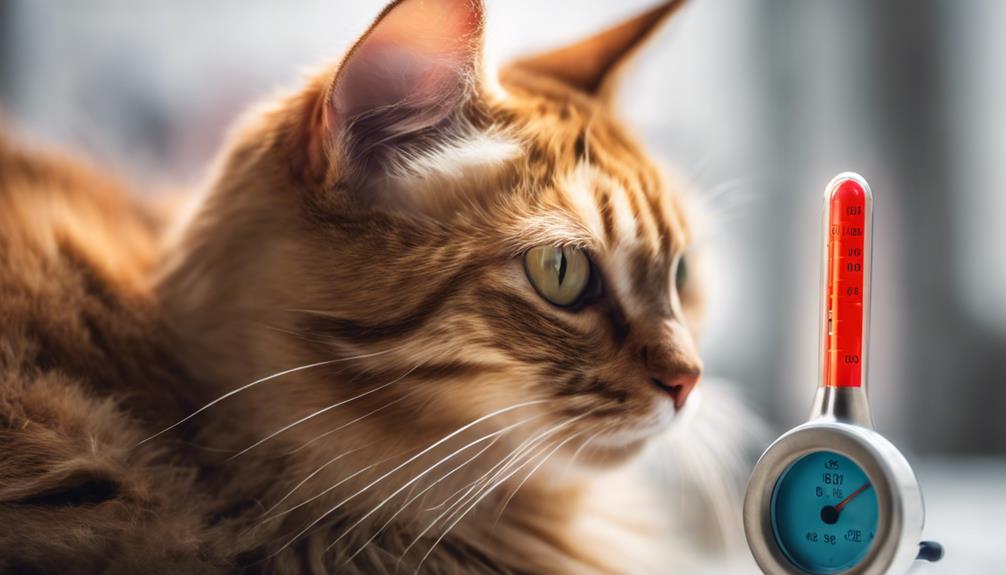
False
Signs of Elevated Temperature
Spotting signs of elevated temperature, such as lethargy and loss of appetite, can help identify fever in cats. When observing your feline friend, look out for these key indicators:
- Lethargy: If your cat is unusually tired or less active than usual, it could be a sign of fever.
- Loss of Appetite: Refusing food or eating noticeably less might indicate an elevated temperature.
- Shivering: Trembling or shivering, especially if accompanied by other symptoms, could be a sign of a fever.
- Checking Body Warmth: Feel the stomach and underarms for unusual warmth, which might suggest a fever.
Monitoring Body Temperature
To accurately monitor a cat's body temperature and identify fever, feeling the ears for warmth can be a valuable indicator. A cat's normal body temperature typically falls between 101° to 102.5°F.
Hot ears in cats may signal a fever, especially when coupled with behavioral changes, lethargy, or reduced appetite. While warm ears alone don't definitively confirm a fever, they can prompt further investigation.
Using a rectal thermometer is the most precise method to check a cat's temperature, with anything above 103°F considered important. If you suspect your feline friend has a fever, it's essential to seek prompt veterinary care.
Your vet can provide guidance on monitoring body temperature and managing fevers in cats effectively.
Dealing With Allergies in Cats
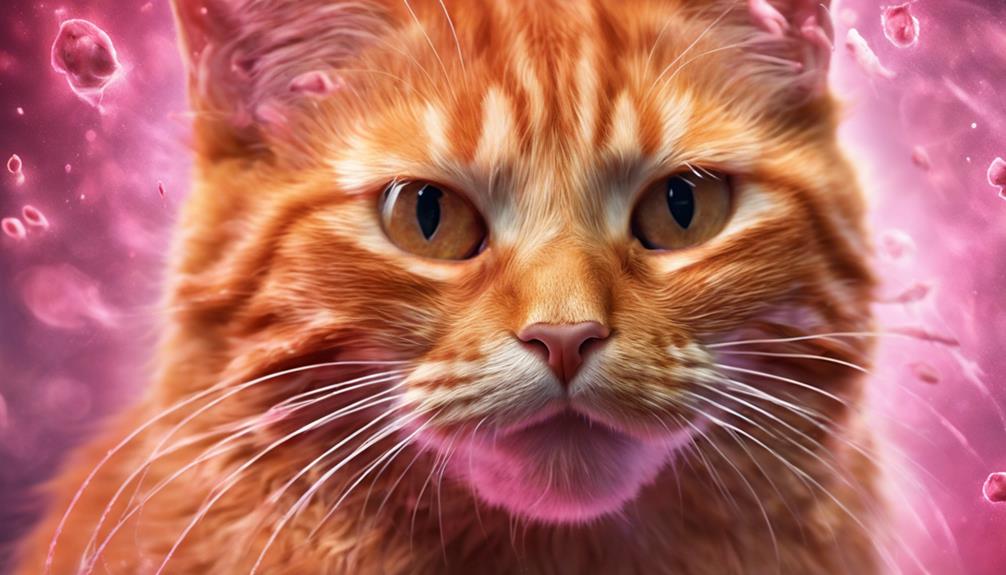
Dealing with allergies in cats requires identifying and addressing the specific irritants that trigger allergic reactions in feline companions. Allergies in cats can be caused by various irritants like pollen, grass, insects, and certain foods. When your cat shows symptoms such as sneezing, wheezing, watery eyes, or excessive licking, it's important to take into account the possibility of allergies. Seeking veterinary care for allergy testing is necessary to pinpoint the exact allergen affecting your cat.
Once the allergen is identified, managing and treating allergic reactions can be done effectively. Here are some strategies for dealing with allergies in cats:
- Consider using antihistamines to alleviate symptoms.
- Allergy shots can help desensitize your cat to specific allergens.
- Making dietary changes may reduce allergic reactions.
- Regular veterinary care and monitoring are essential to guarantee your cat's health and well-being.
Addressing Ear Mite Infestations
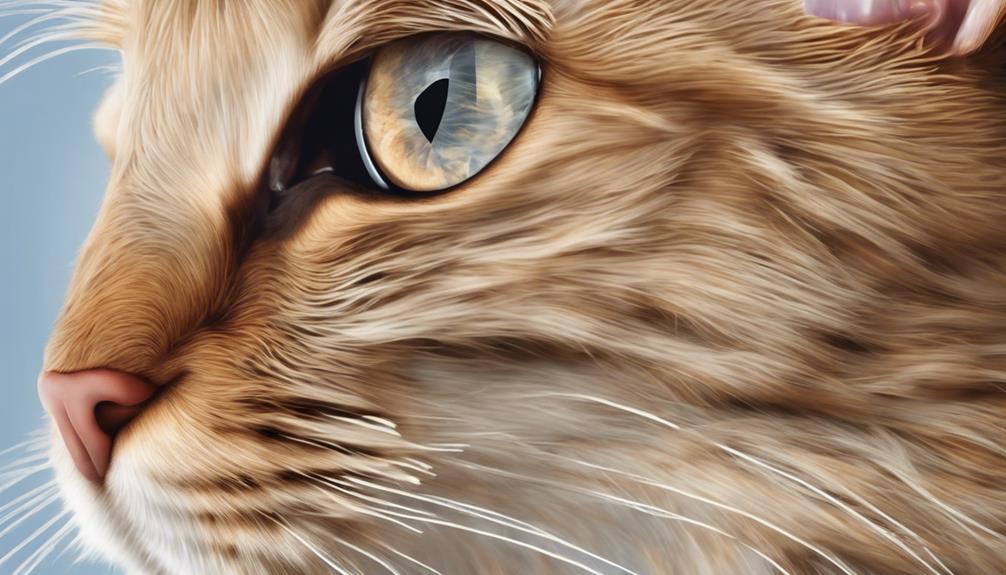
When addressing ear mite infestations in cats, it's essential to identify the symptoms, such as excessive scratching and dark discharge in the ears.
Treatment for ear mites typically involves medication prescribed by a veterinarian, and regular cleaning is vital for preventing further issues.
Identifying Ear Mites
Identifying ear mites in cats involves closely examining the ear canal for dark discharge resembling coffee grounds. When dealing with ear mites, it's vital to pay attention to the following signs:
- Presence of dark discharge in the ear canal
- Itching and discomfort exhibited by the cat
- Inflammation and heat in the ears
- Potential for secondary infections if left untreated
If you notice these symptoms, it's important to seek prompt attention from a veterinarian. Professional treatment is necessary to effectively eliminate ear mites and prevent further discomfort for your feline friend. Remember, addressing ear mite infestations promptly can help safeguard your cat's ear health and overall well-being.
Treating Ear Mite Infections
To effectively address ear mite infestations in cats, prompt veterinary intervention with proper medication is vital. When a cat has hot ears or if you notice dirty, highly contagious ear mites, seeking medical help promptly is imperative. Ear mites can spread quickly, causing discomfort and potential ear infections.
Over-the-counter treatments may not be effective against these pesky parasites. A veterinarian will be able to diagnose the issue accurately and prescribe the appropriate medication to treat the infestation. Remember, ear mites are highly contagious, so it's crucial to address the problem promptly to prevent it from spreading to other pets or even to humans.
Managing Cat Ear Infections

One essential aspect in caring for cats is effectively managing ear infections caused by bacteria, yeast, or ear mites.
When dealing with cat ear infections, it's important to take into account the following:
- Symptoms: Keep an eye out for signs like pain, head shaking, and altered balance, which could indicate an ear infection.
- Complications: Untreated infections can lead to serious issues, including hearing loss, so immediate attention is vital.
- Veterinary Attention: Seeking immediate help from a vet is essential for accurate diagnosis and appropriate treatment.
- Treatment: Treatment options may include antibiotics, antifungal medications, and regular ear cleaning to address the infection.
Cats Natural Temperature Control

Cats naturally regulate their body temperature by increasing blood flow to their ears, paws, and nose. When you notice your cat's ears feeling warm, it's often a sign of this natural temperature control mechanism at work. Increased blood flow to the ears helps your feline friend release excess heat, especially when the environmental temperature changes.
Those cute, warm ears aren't just adorable but also crucial for your cat's well-being. The veins in their ears expand when it's warm to allow heat to escape and constrict when it's cold to maintain heat within the body. By understanding how cats use their ears to manage body temperature, you can guarantee they stay comfortable and healthy.
Signs of Fever in Cats
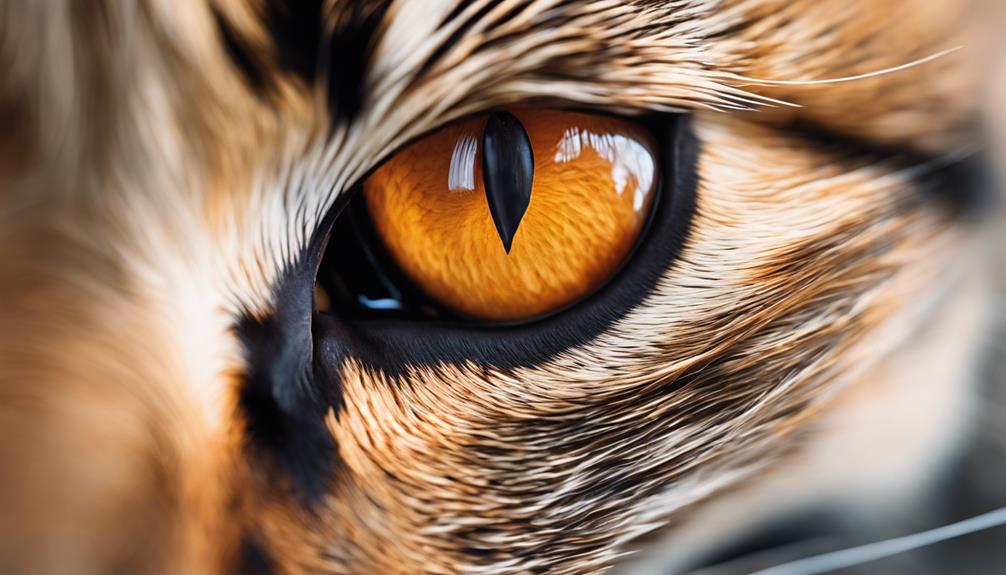
When a cat's body temperature rises above 103.5°F, it indicates the presence of a fever. Signs of fever in cats may include:
- Lethargy, where your feline friend seems unusually tired and less active than usual.
- Loss of appetite, as cats with fevers often show a decrease in their interest in food.
- Shivering, where your cat may tremble or shake involuntarily in response to the increased body temperature.
- Using a rectal thermometer is the most accurate way to check your cat's temperature and confirm the presence of a fever.
If your cat's fever persists above 104°F, it's important to seek immediate veterinary attention. Additionally, isolating behavior and a change in appetite can also be indicators of fever in cats.
Monitoring your cat's body temperature and being attentive to these signs can help you detect a fever early and make sure your furry companion receives the necessary care promptly.
Coping With Allergies in Cats

To address allergies in cats, understanding common triggers like pollen, grass, insects, and certain foods is vital for effective management. Cats with allergies may exhibit symptoms such as bloating, sneezing, wheezing, watery eyes, and hot ears.
If you notice your feline friend excessively licking their ears, it could be a sign of allergies affecting them. It's important to consult a veterinarian for allergy testing to pinpoint the specific irritants causing reactions in your cat.
By identifying the allergens, you can then explore effective solutions like antihistamines to help manage your cat's allergies and provide them with relief. Remember, each cat may react differently to various allergens, so tailored approaches based on allergy testing results are key to finding the best way to cope with your cat's allergies.
Remedies for Ear Mite Problems
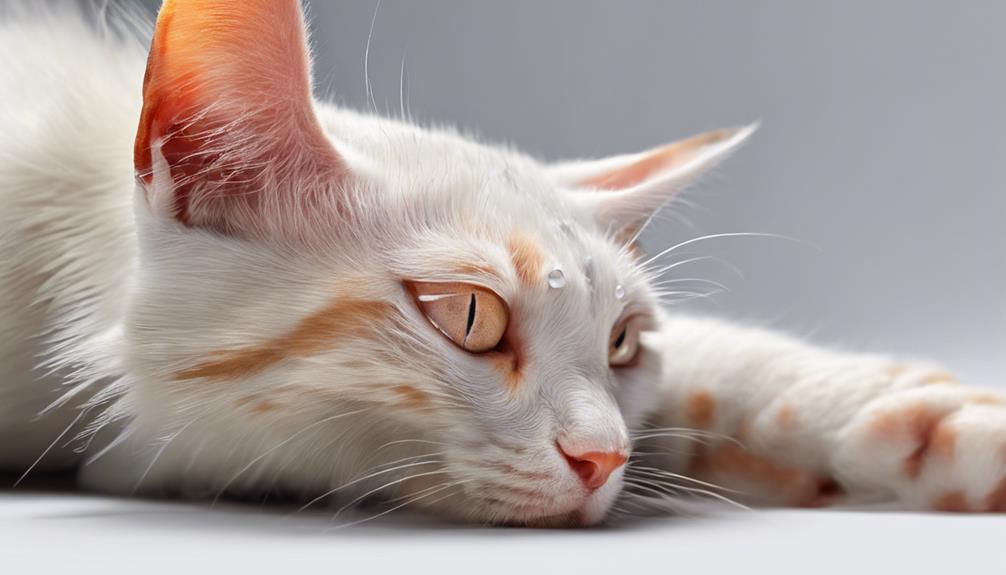
Upon noticing symptoms of ear mite infestation in your pet, seeking proper medication from a vet is essential for effective treatment. Ear mites are tiny parasites that cause intense itching and discomfort in cats. Symptoms of ear mite infestation include dark discharge resembling coffee grounds in the ears. If left untreated, ear mites can spread to other pets and even humans, highlighting the importance of prompt intervention.
While over-the-counter remedies may be available, they may not provide adequate treatment for ear mites in cats.
- Seek proper medication from a vet for effective treatment.
- Watch out for symptoms like dark discharge in the ears.
- Remember that ear mites can spread to other pets and humans if left untreated.
- Be cautious with over-the-counter remedies, as they may not offer sufficient relief for ear mite problems in cats.
Taking swift action and following the vet's advice can help alleviate your cat's discomfort and prevent the spread of ear mites.
Frequently Asked Questions
Should I Be Worried if My Cats Ears Are Hot?
If our cats' ears feel hot without other concerning signs, it might not be worrisome. Still, we suggest monitoring. Hot ears can be normal for temperature regulation. But if in doubt, consulting a vet is wise.
What Are the Symptoms of Fever in Cats?
When cats have a fever, they might show signs like lethargy, loss of appetite, and shivering. It's important to keep an eye out for unusual warmth in their belly and underarms. A fever above 104°F demands immediate vet care.
Why Does My Cats Ear Look Burnt?
Our cat's ear may look burnt due to excessive sun exposure causing sunburn. This can lead to redness, peeling, and discomfort. Protecting their ears with shade, sunscreen, or hats can prevent burns. Consult a vet if concerned.
Why Does My Cat's Head Feel Warm?
When our cat's head feels warm, it may indicate various issues like fever, infections, or even just the body regulating temperature. Monitoring for other symptoms is essential. If concerned, consulting a vet promptly is wise.
Conclusion
To summarize, when your cat's ears feel hot, it could be due to a variety of reasons such as hot weather, allergic reactions, fever, or ear mites. Monitoring your cat's temperature and behavior is essential for their health and well-being.
Remember, just like us, cats have their ways of regulating their body temperature. So, keep an eye out for any signs of discomfort and consult your veterinarian if needed.
Stay cool, cat lovers!
Paul’s love for animals knows no bounds. As a dedicated writer and animal lover, Paul brings a unique perspective to our team. His firsthand experiences with various animals enrich our content and provide valuable insights into their behavior and needs. Whether he’s sharing tips for pet care or shedding light on pressing conservation issues, Paul’s passion for animals shines through in everything he does.
-

 Vetted2 months ago
Vetted2 months ago15 Best Cat Foods for Managing Hyperthyroidism – Vet Approved and Feline Friendly
-

 Animal Facts2 months ago
Animal Facts2 months agoSpring Animals: A Guide to Seasonal Wildlife
-

 Vetted2 months ago
Vetted2 months ago15 Best Dog Foods for Kidney Disease – Expert Recommendations for Your Pet's Health
-

 Cats7 months ago
Cats7 months agoTop 5 Cat Breeders in Arkansas: A Guide
-

 Vetted2 months ago
Vetted2 months ago15 Best Fresh Dog Food Delivery Services for Your Pup's Health and Happiness
-

 Rabbits2 months ago
Rabbits2 months agoExploring Rabbit Holes: What Do They Look Like?
-

 Pets2 months ago
Pets2 months agoLatest Pet Statistics in US – Trends & Insights in 2024
-

 Fish2 months ago
Fish2 months agoKeeping Your Sucker Fish Thriving at Home





















